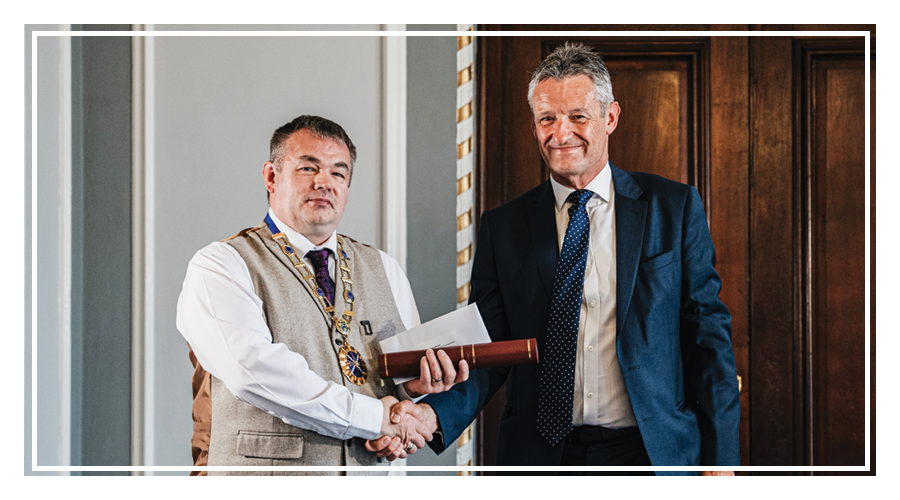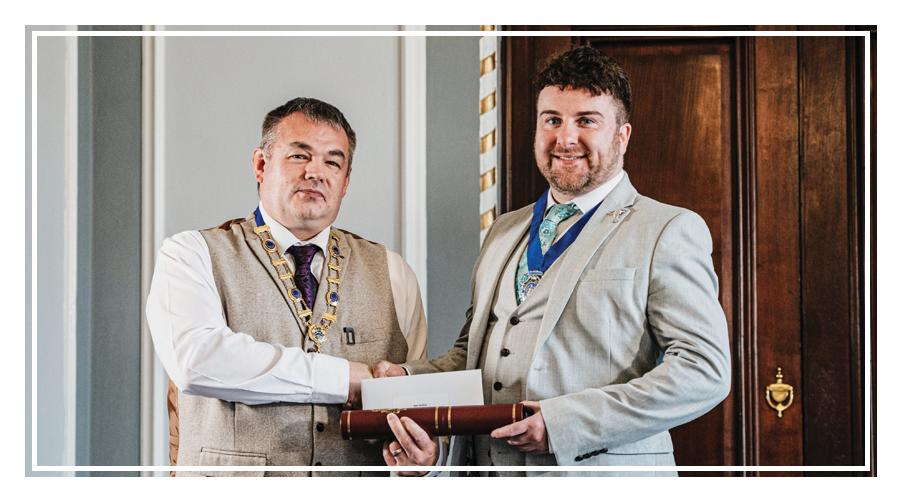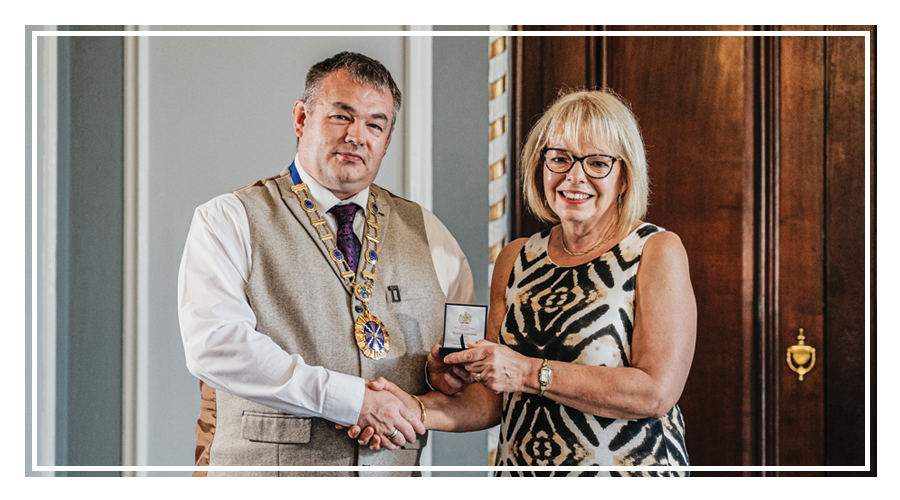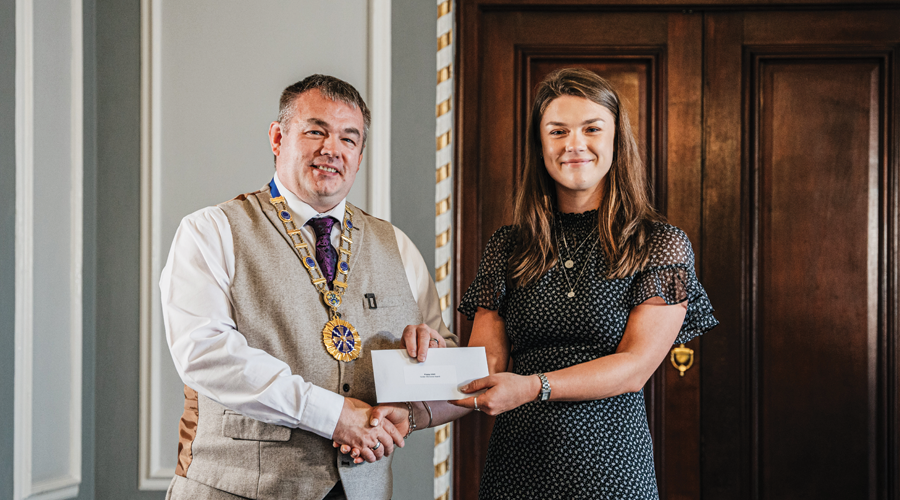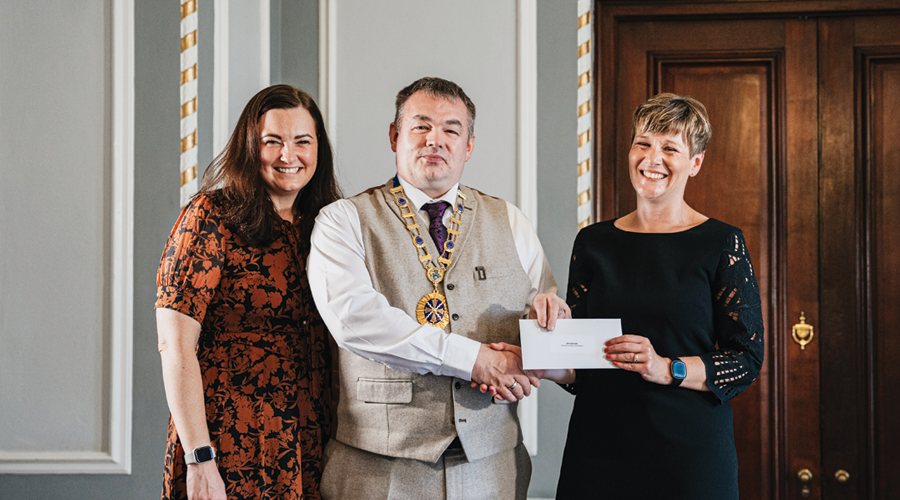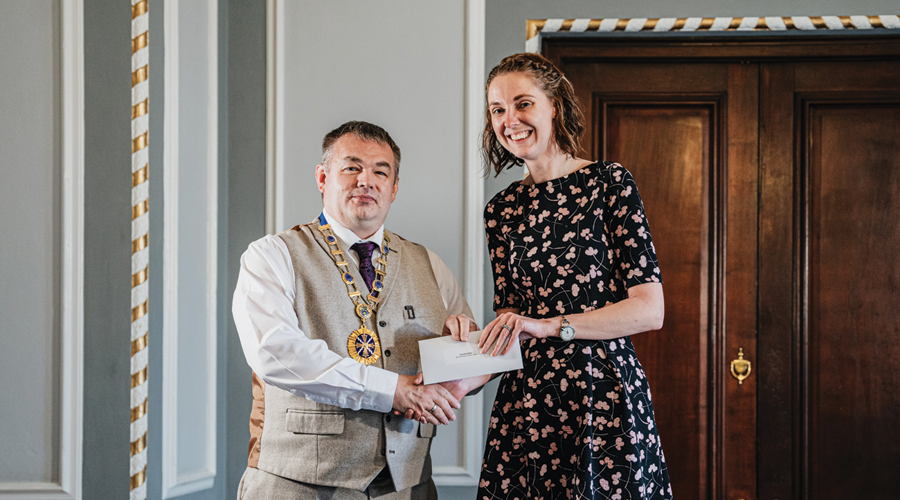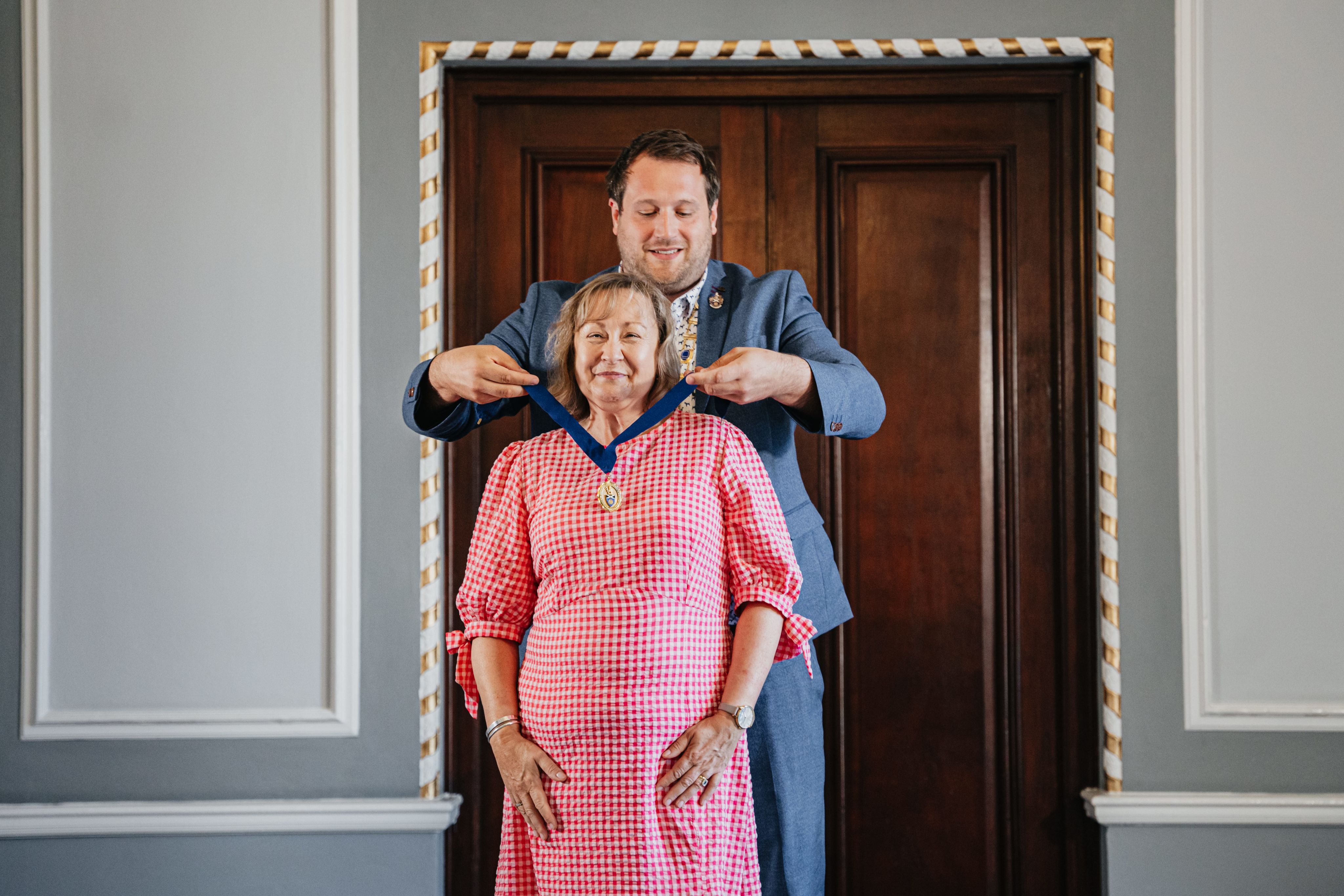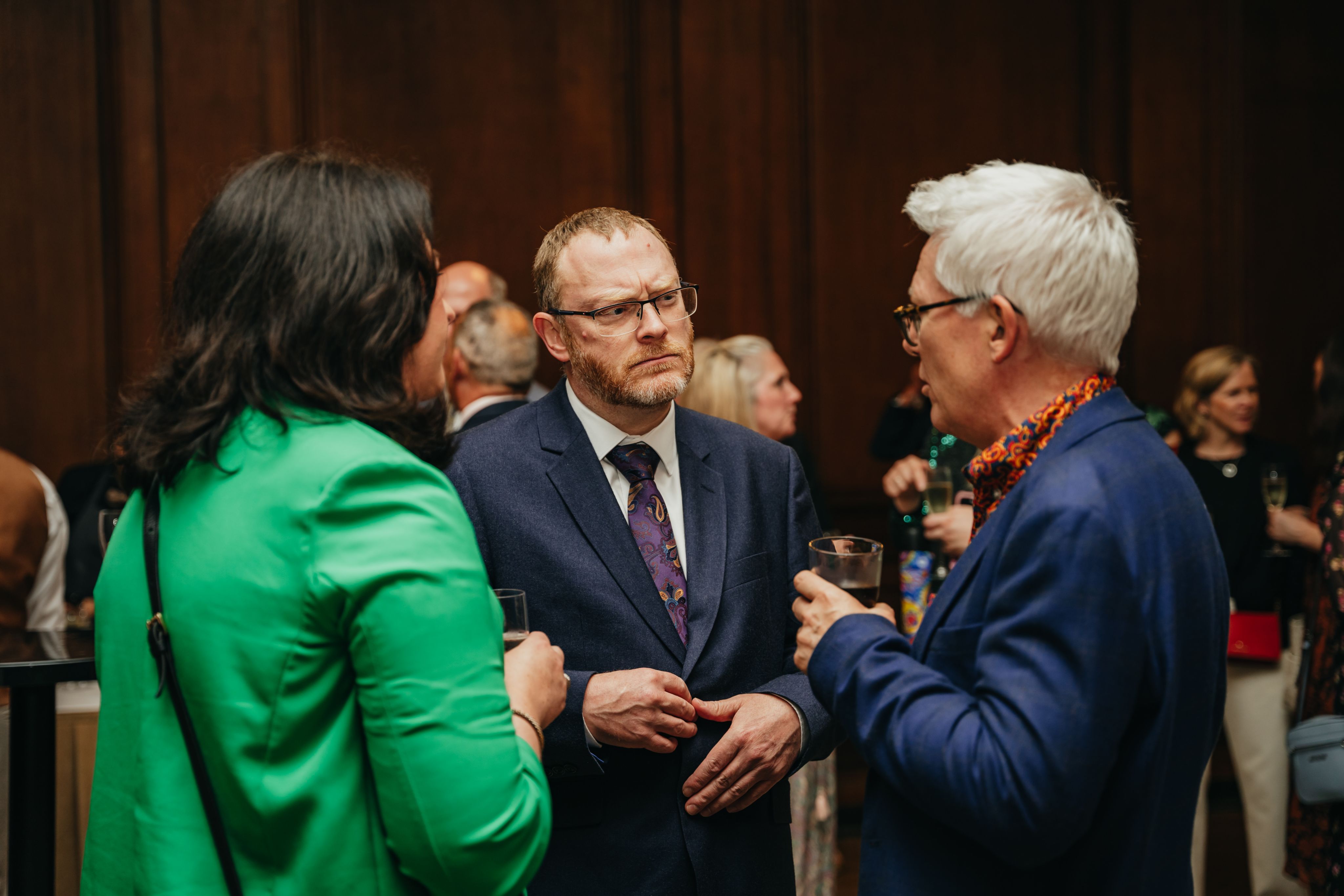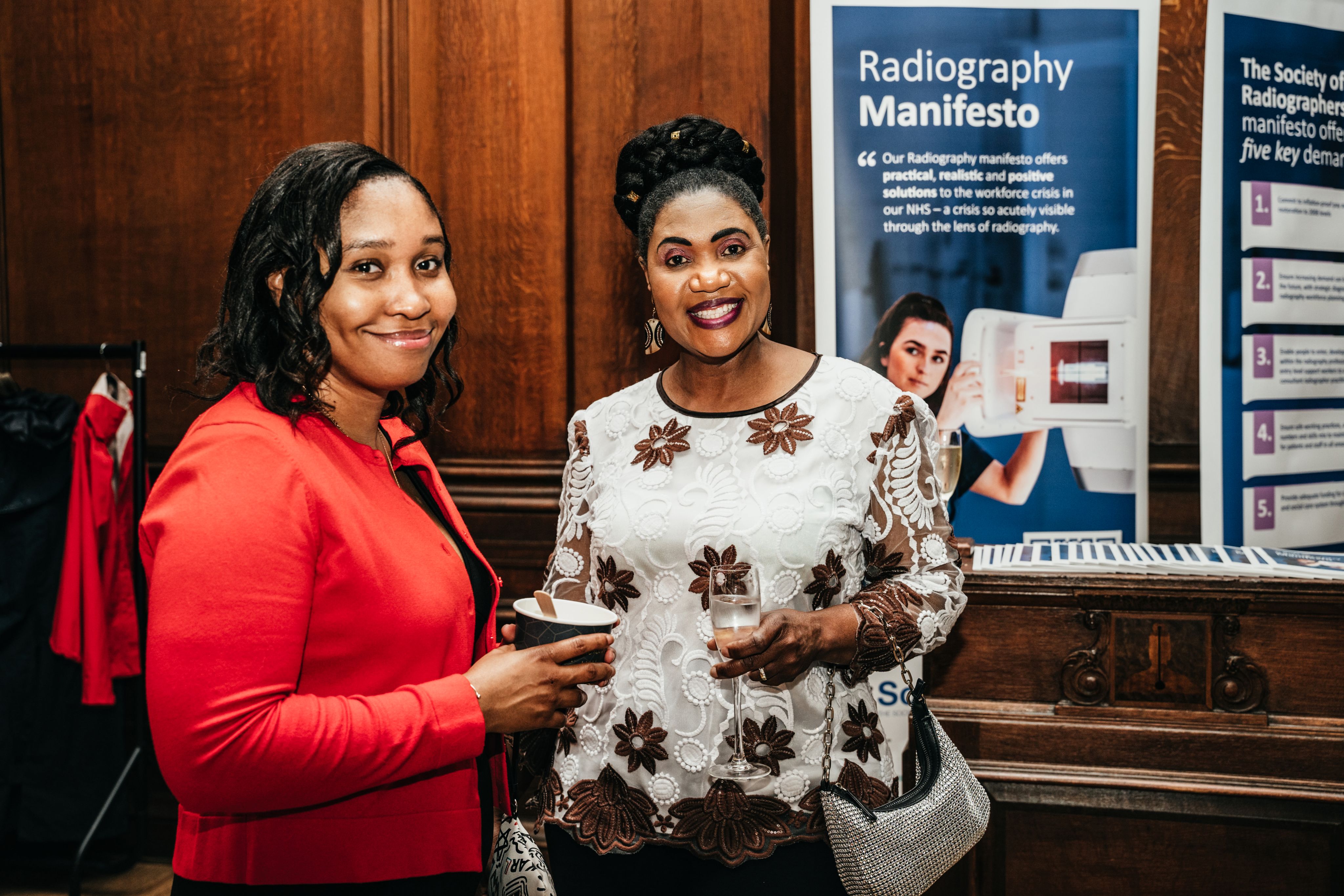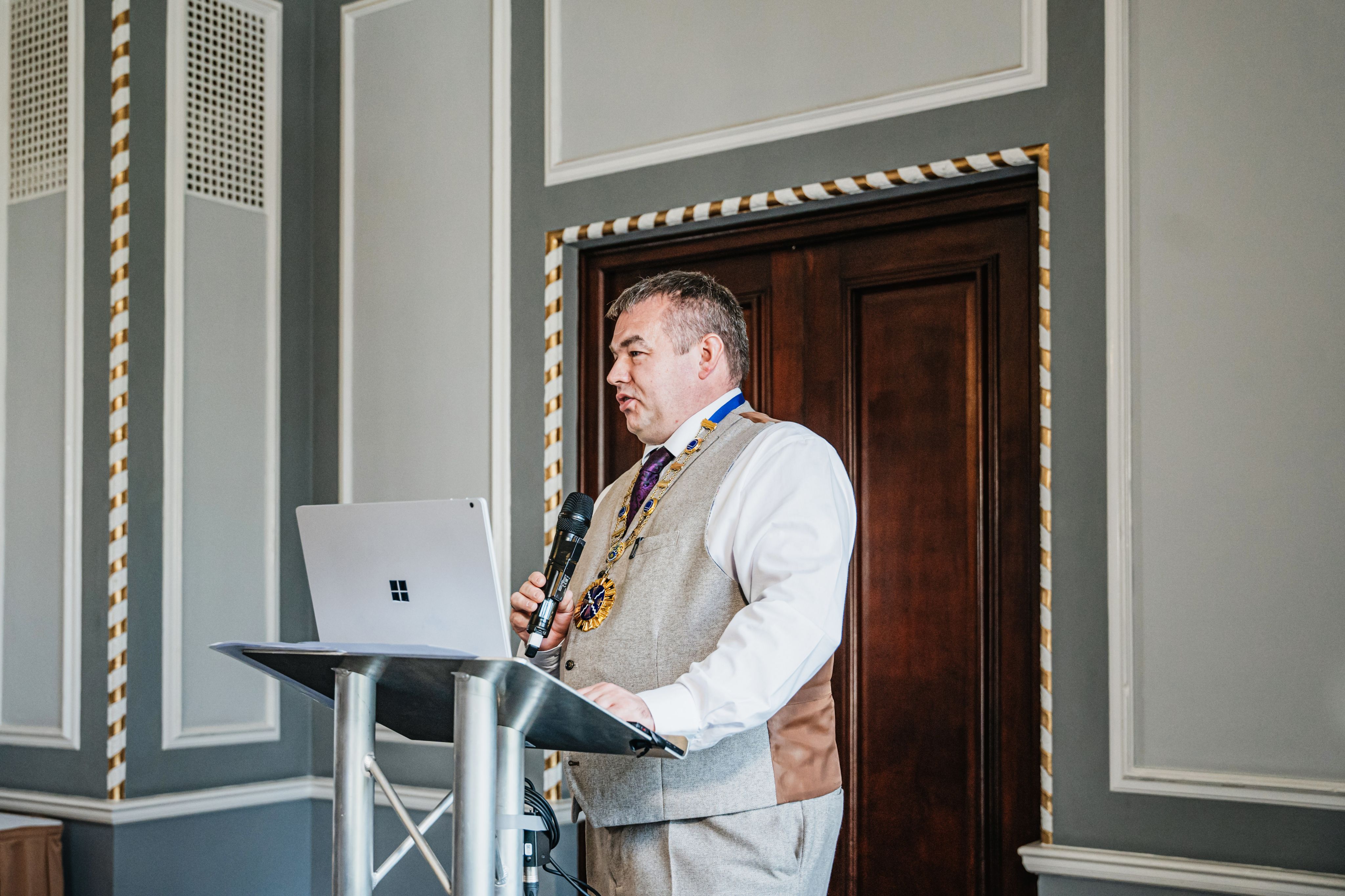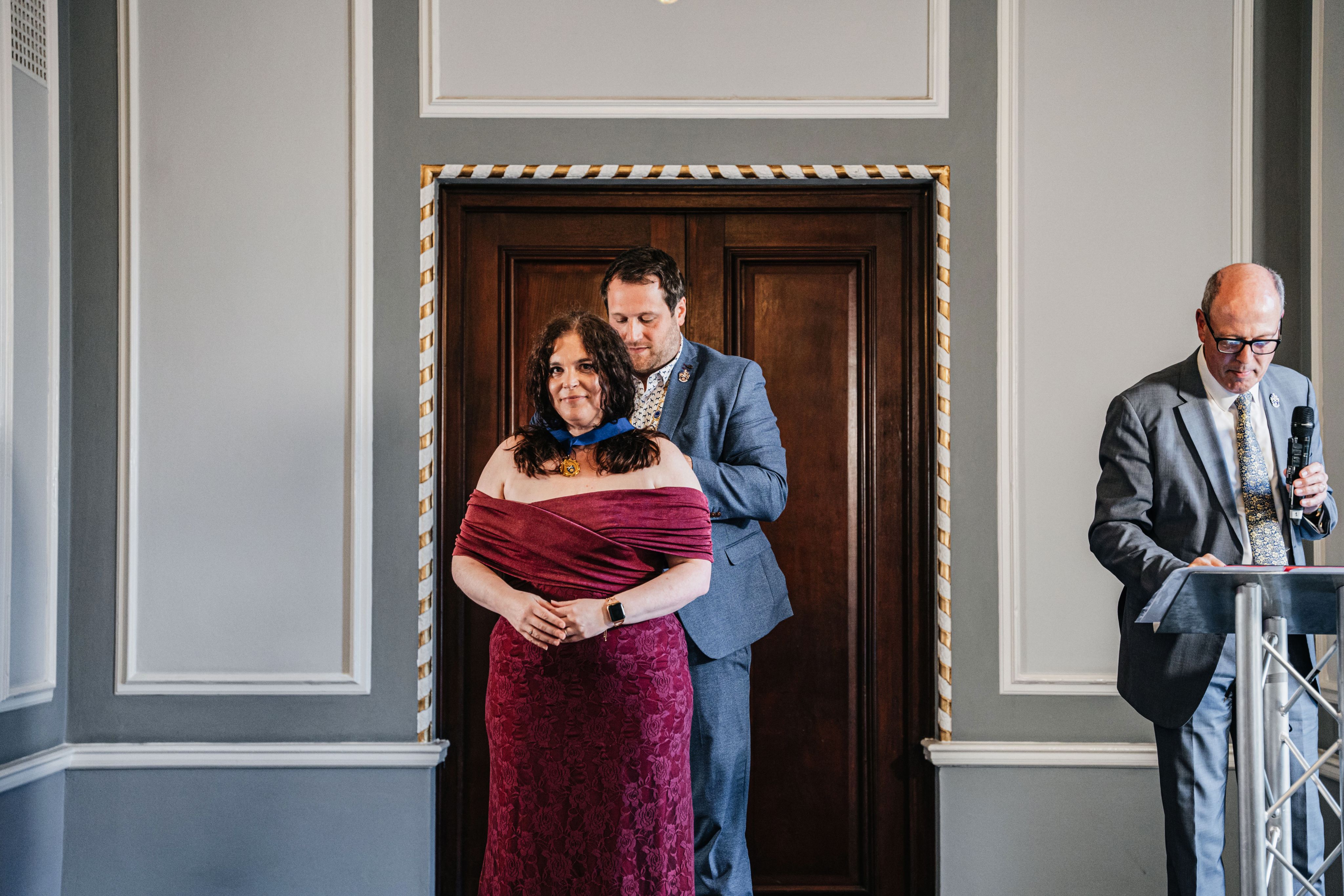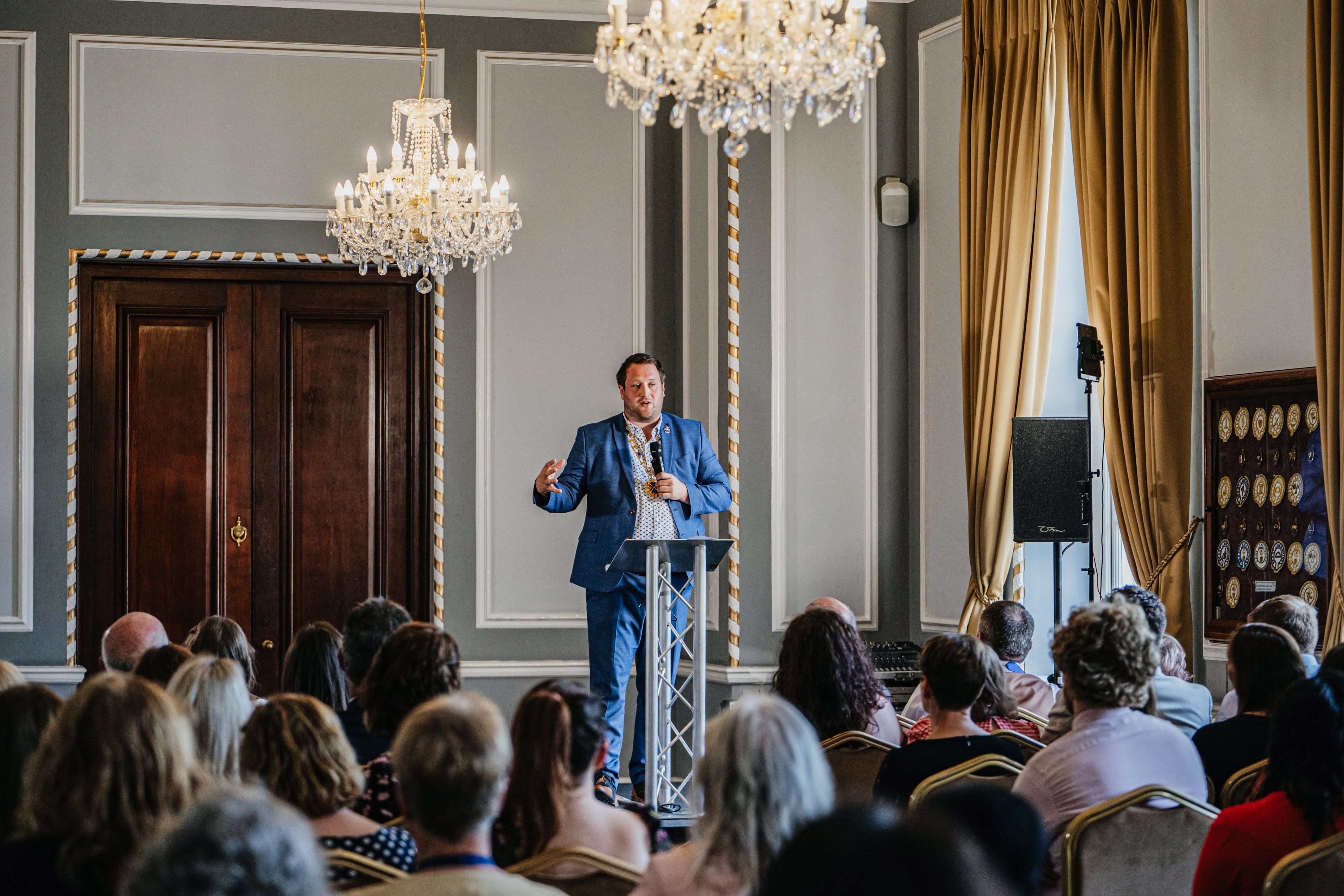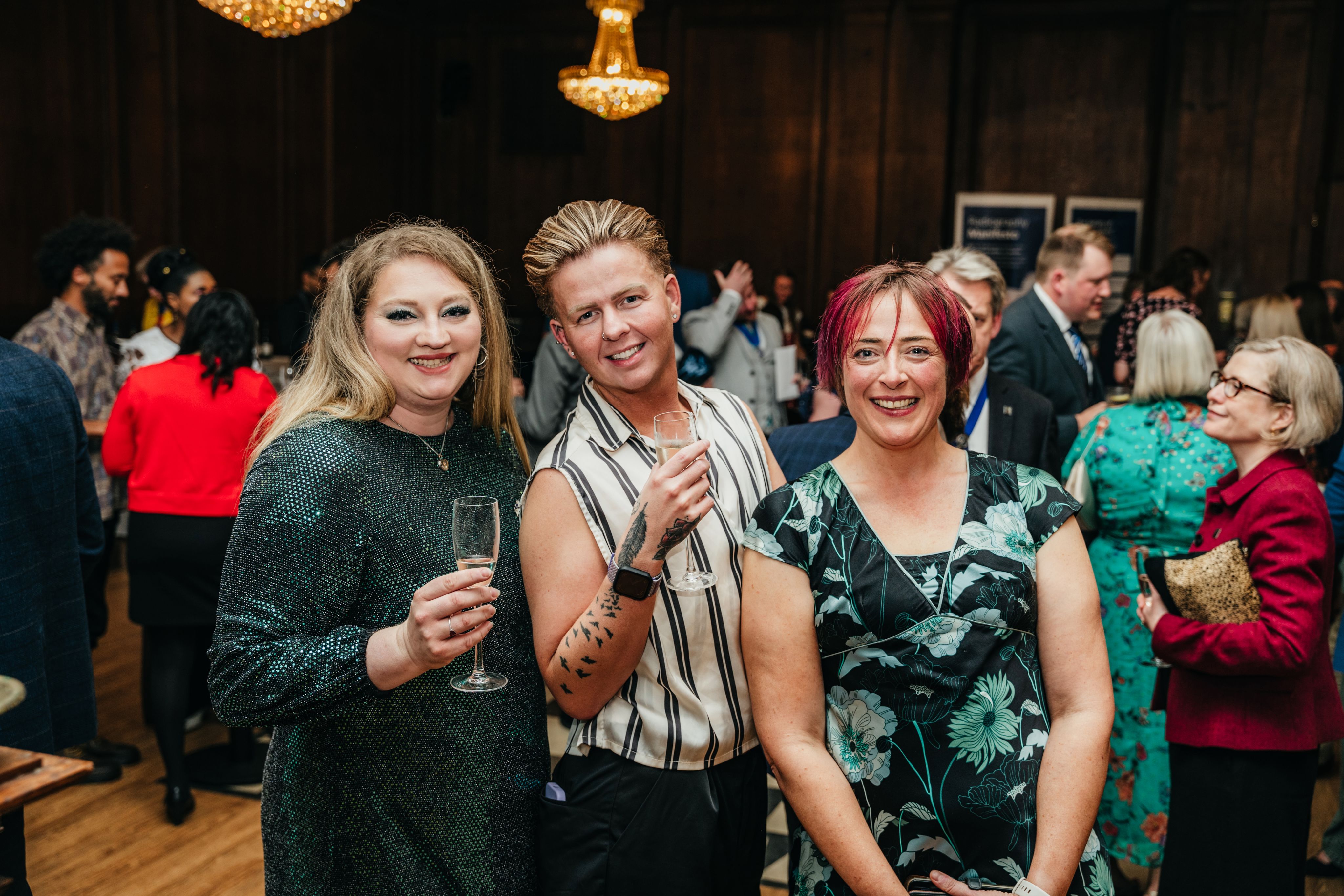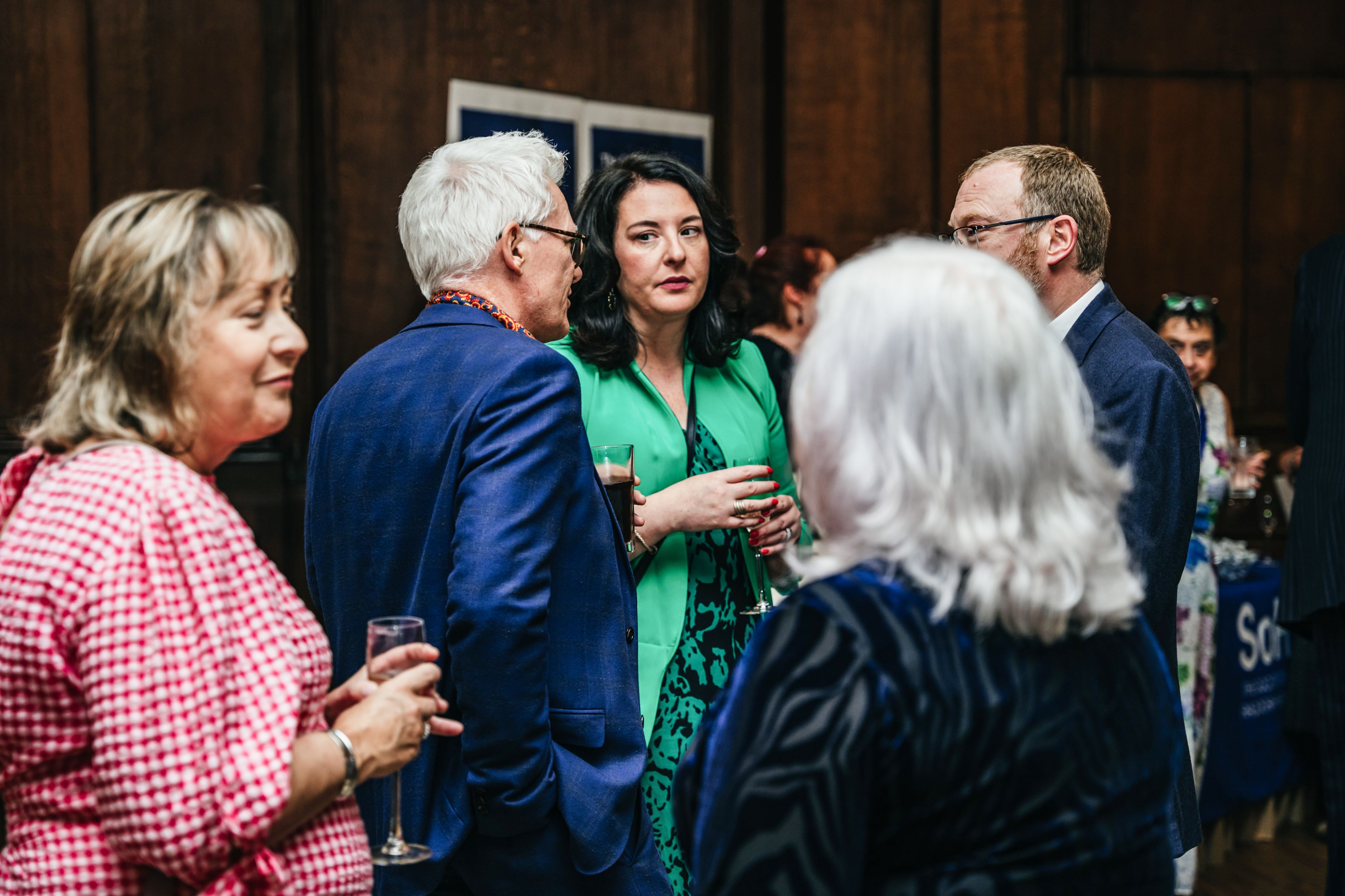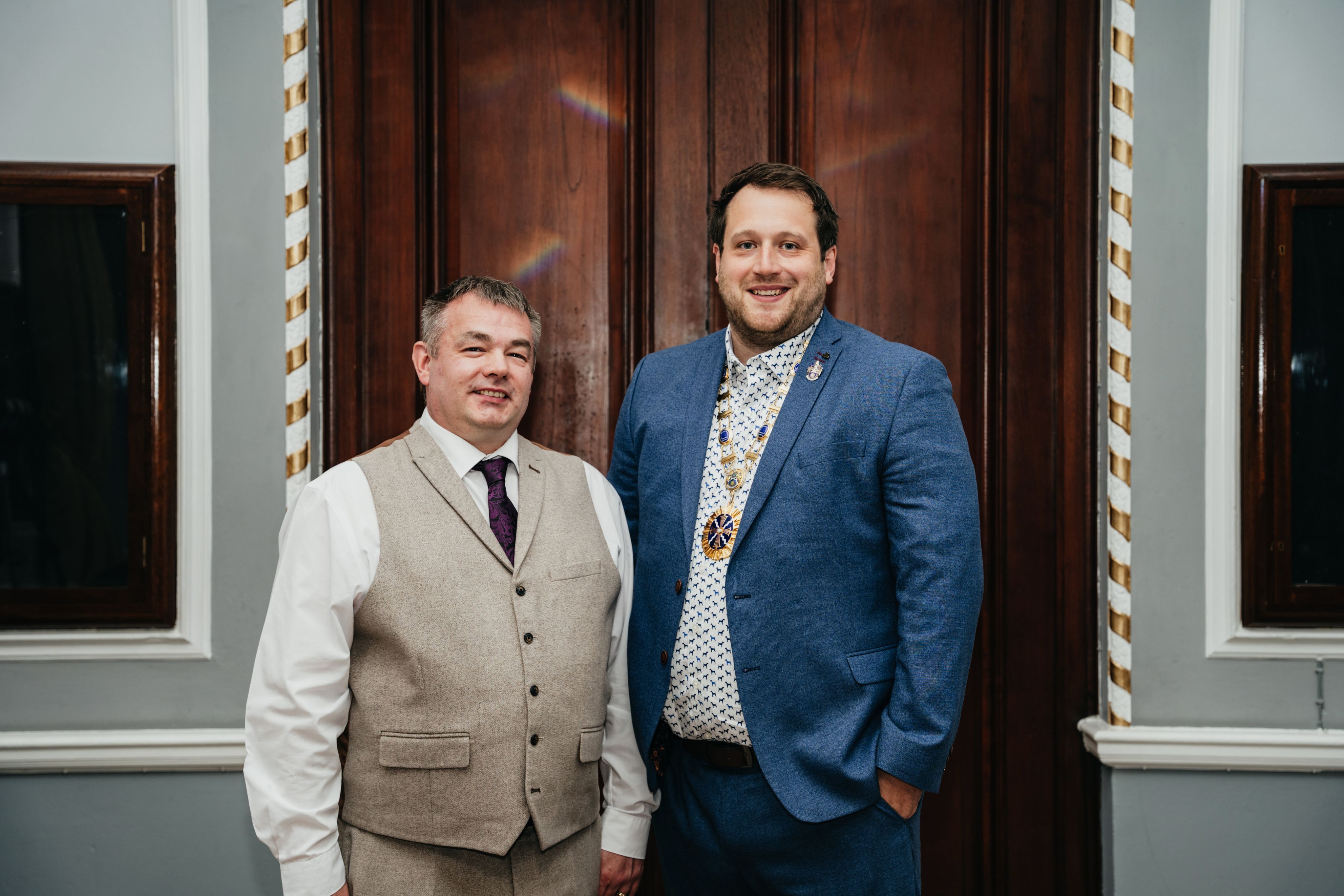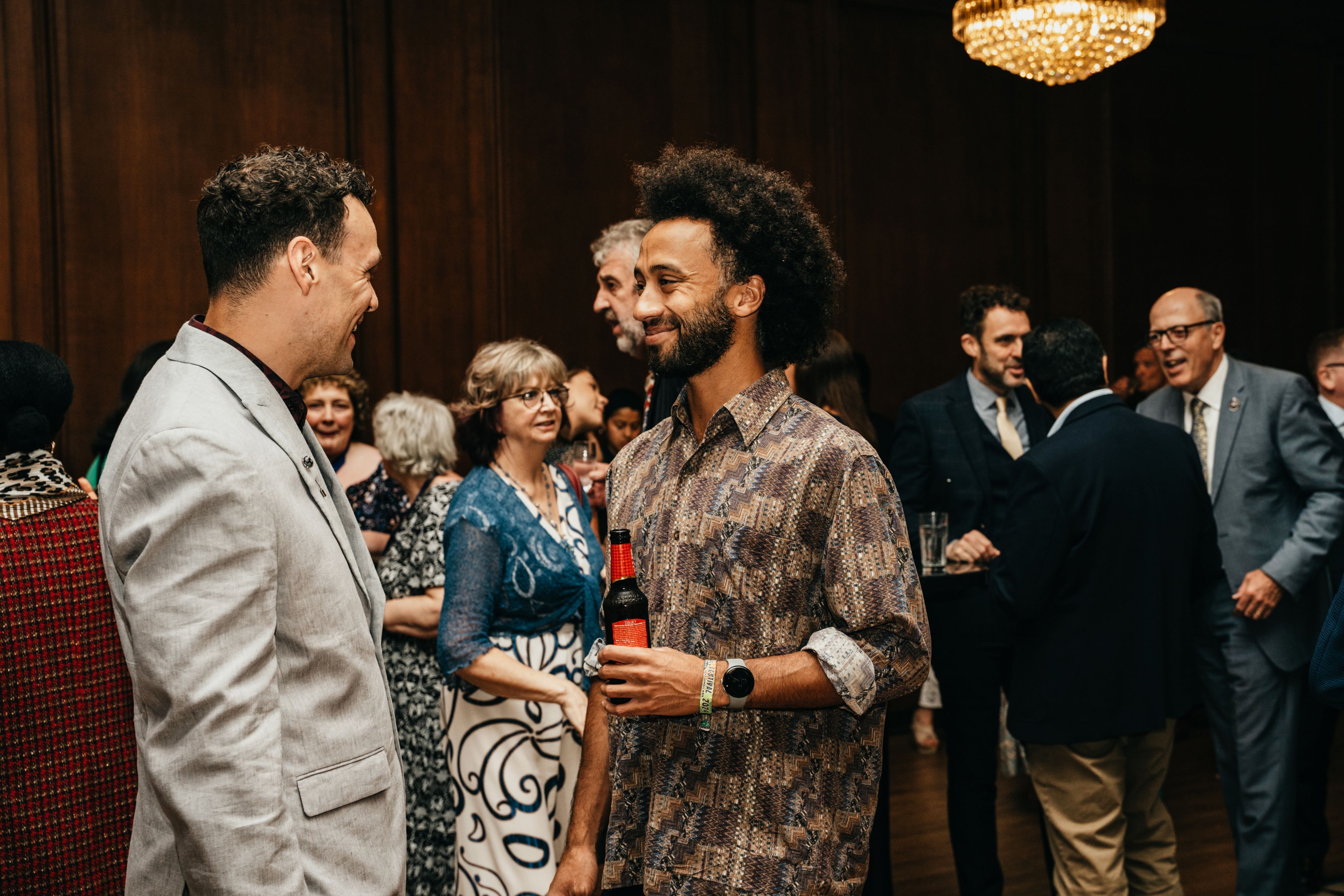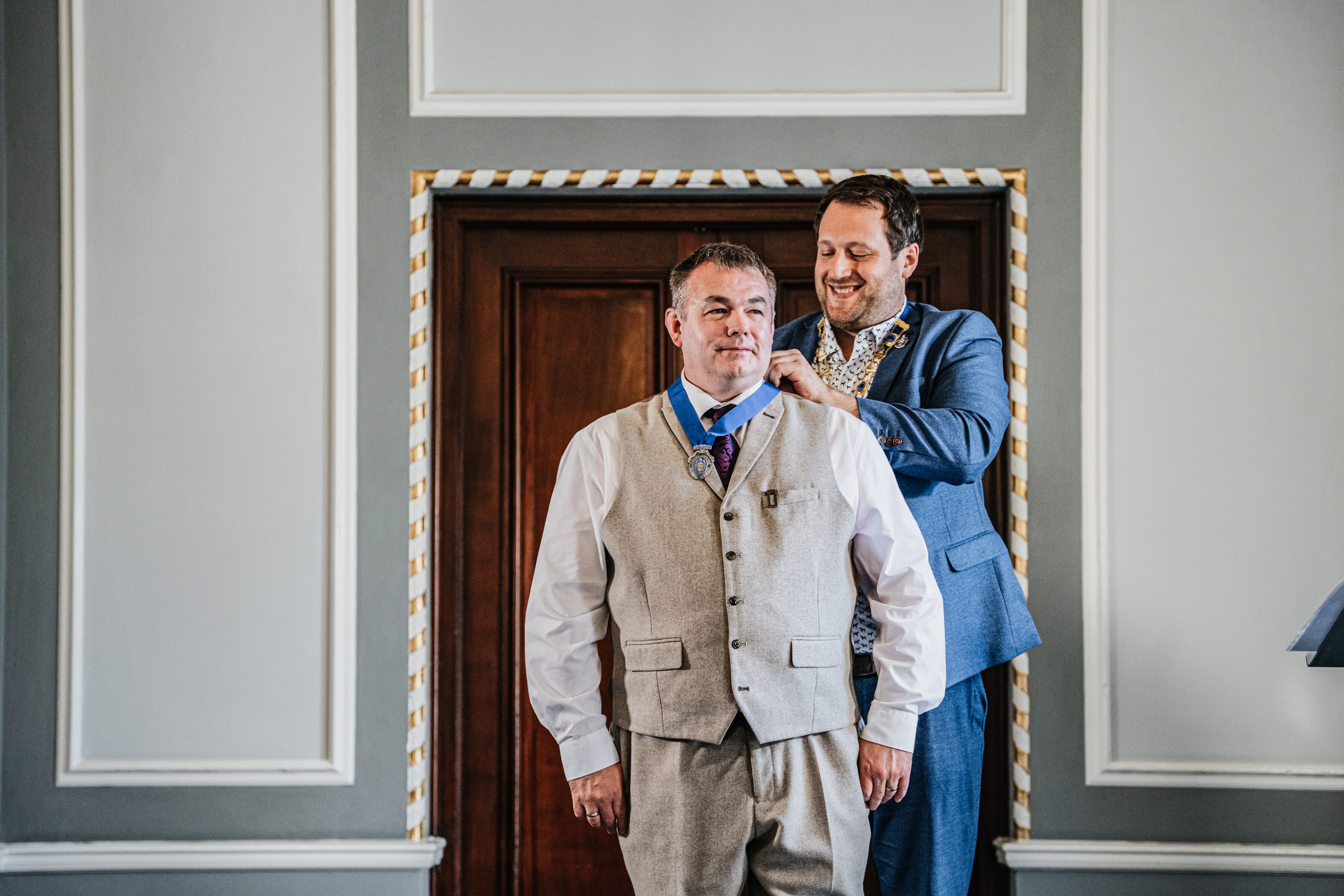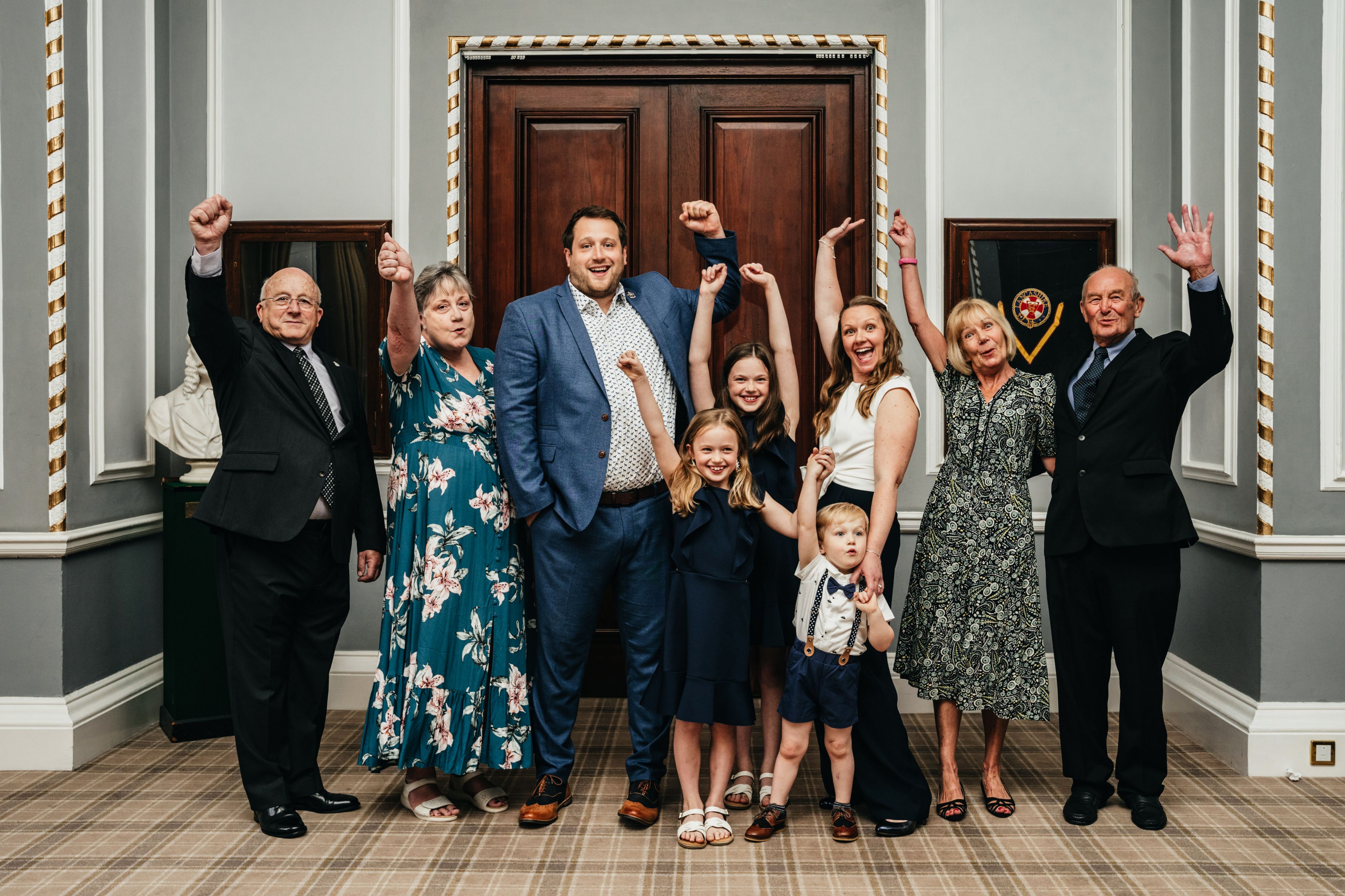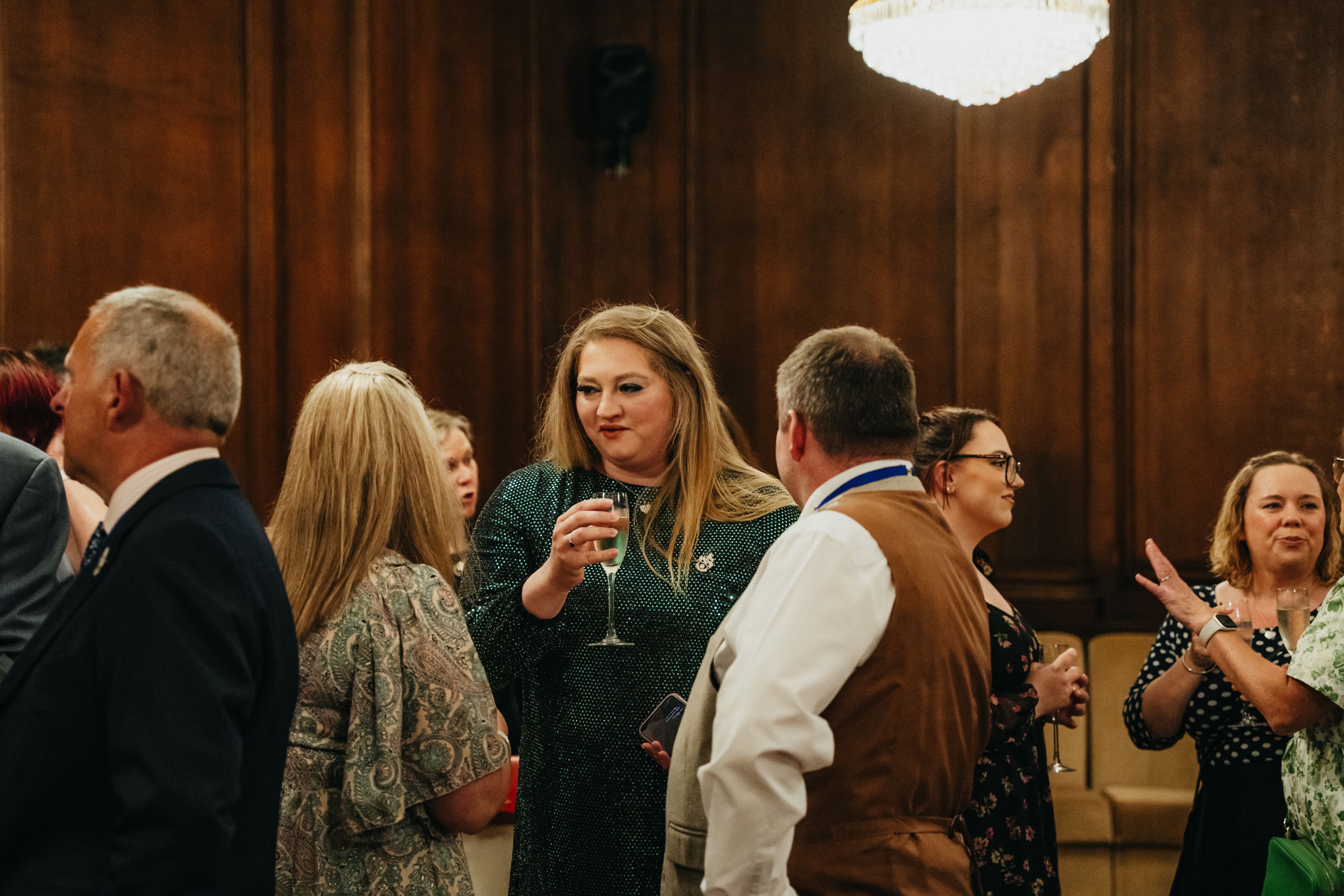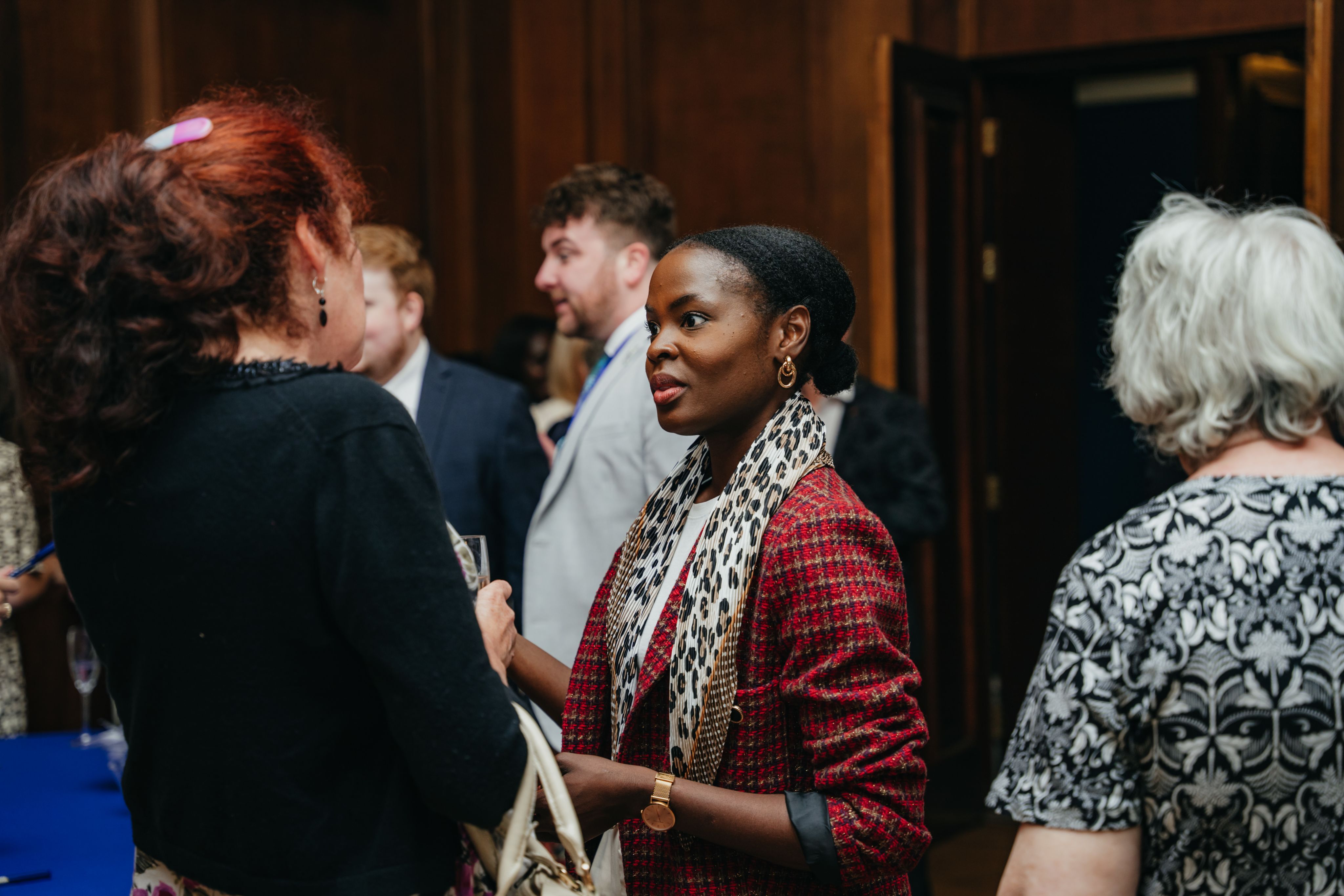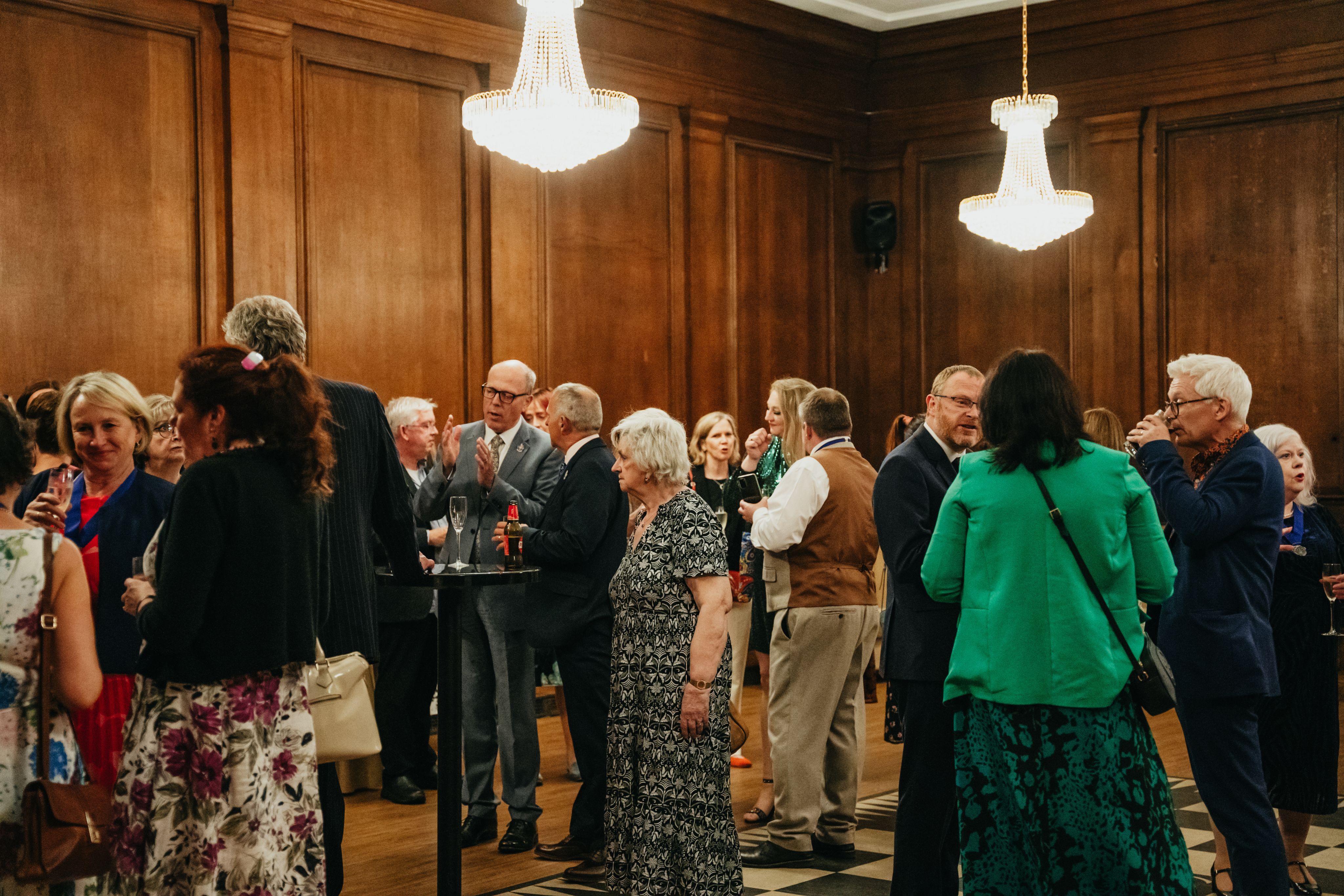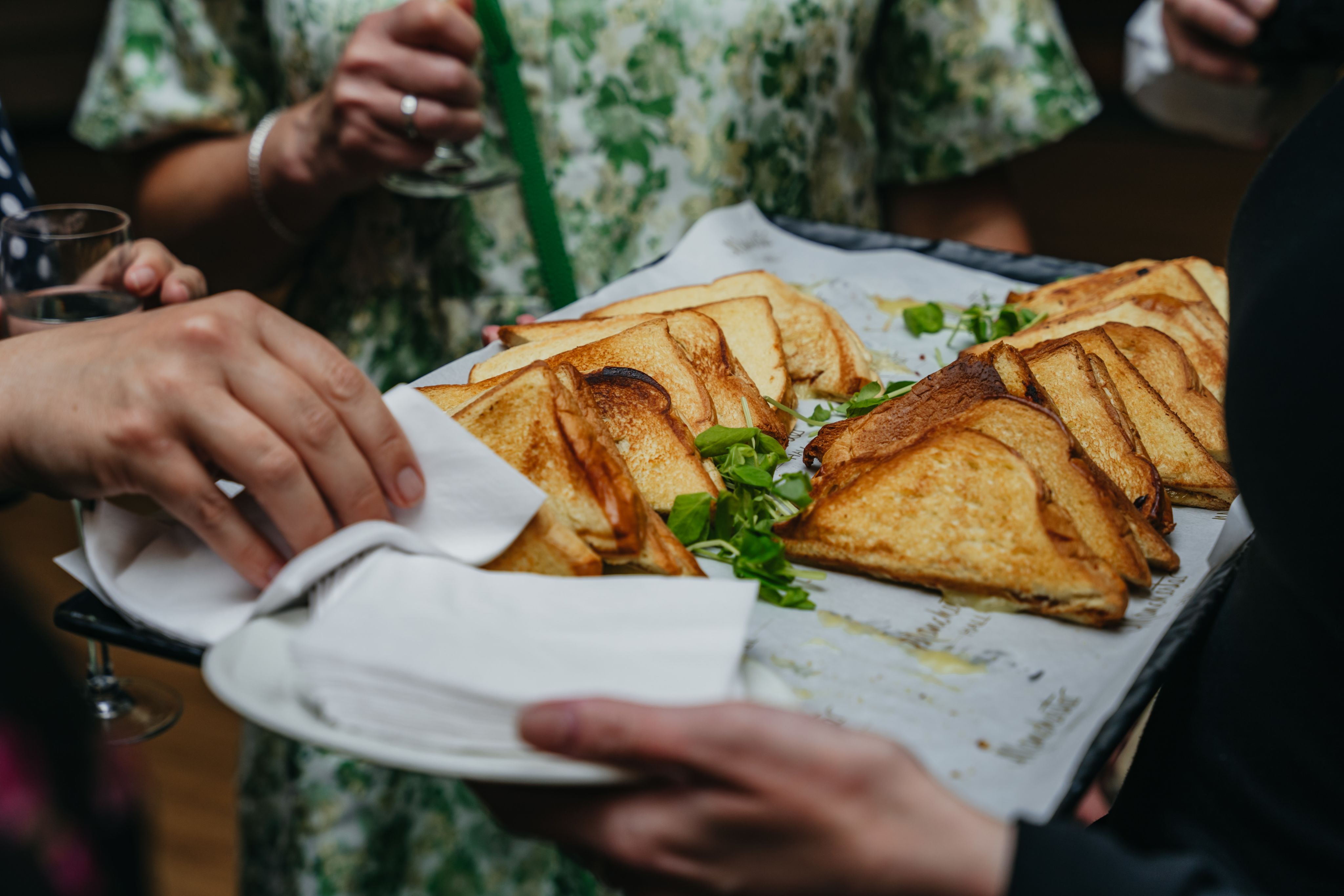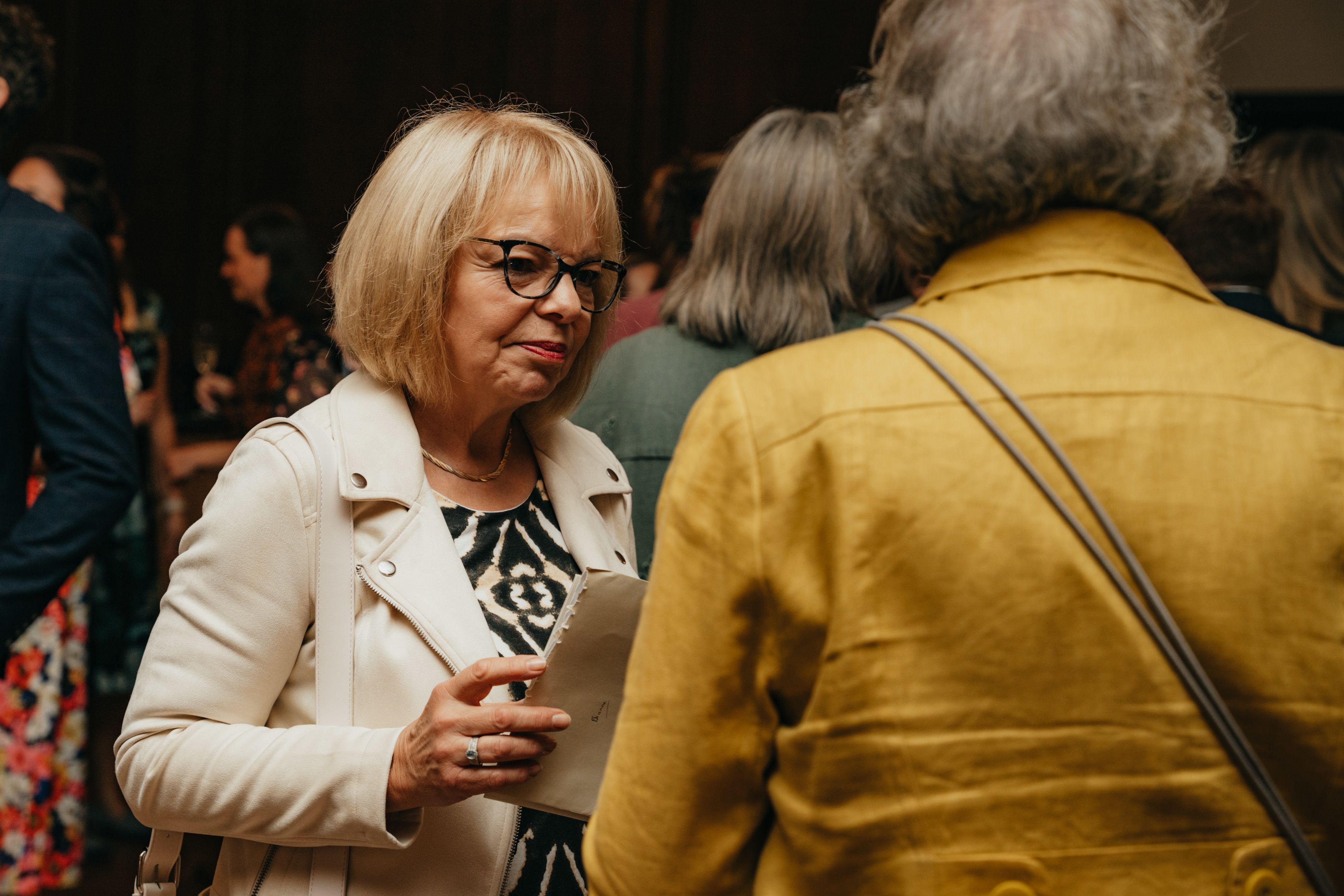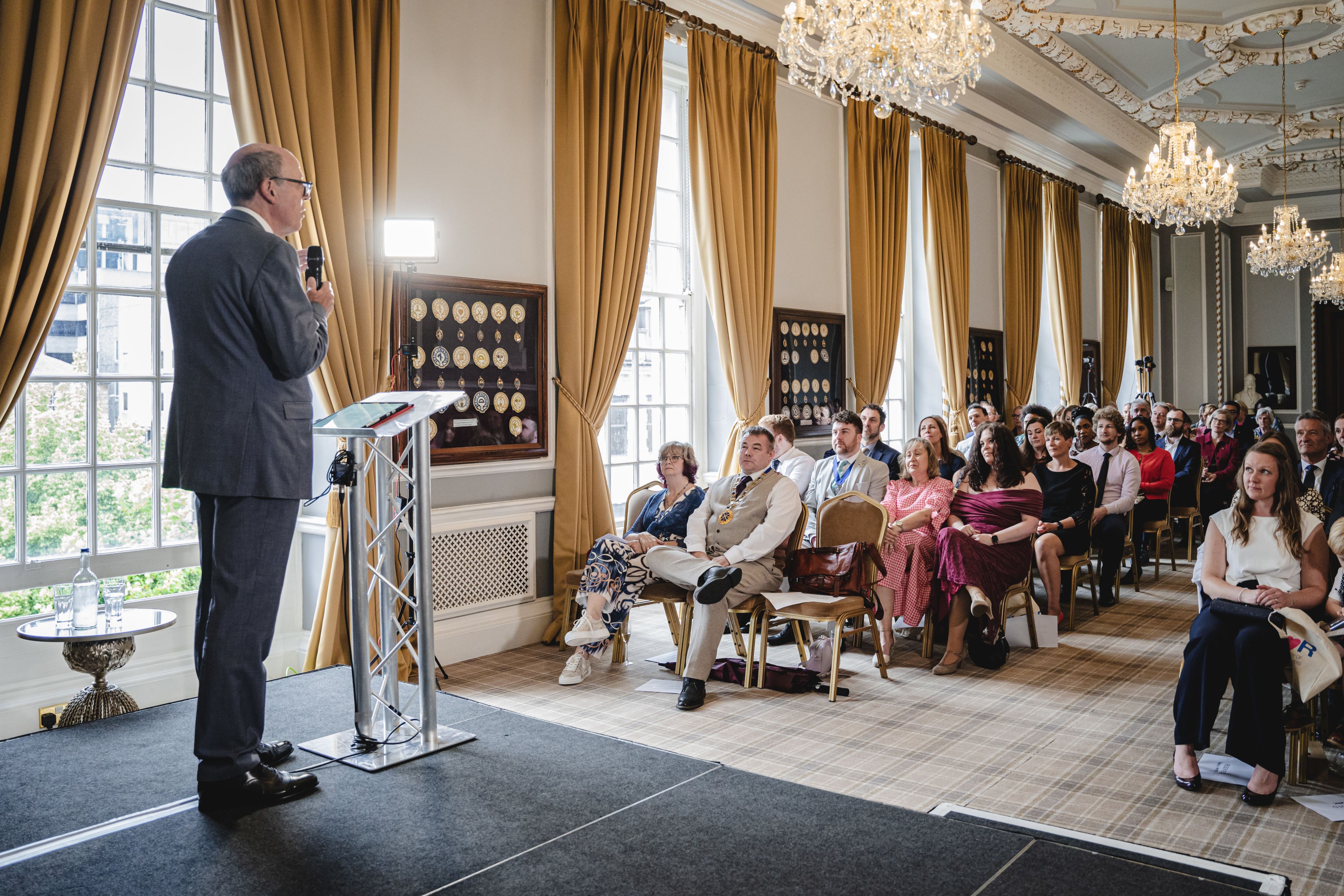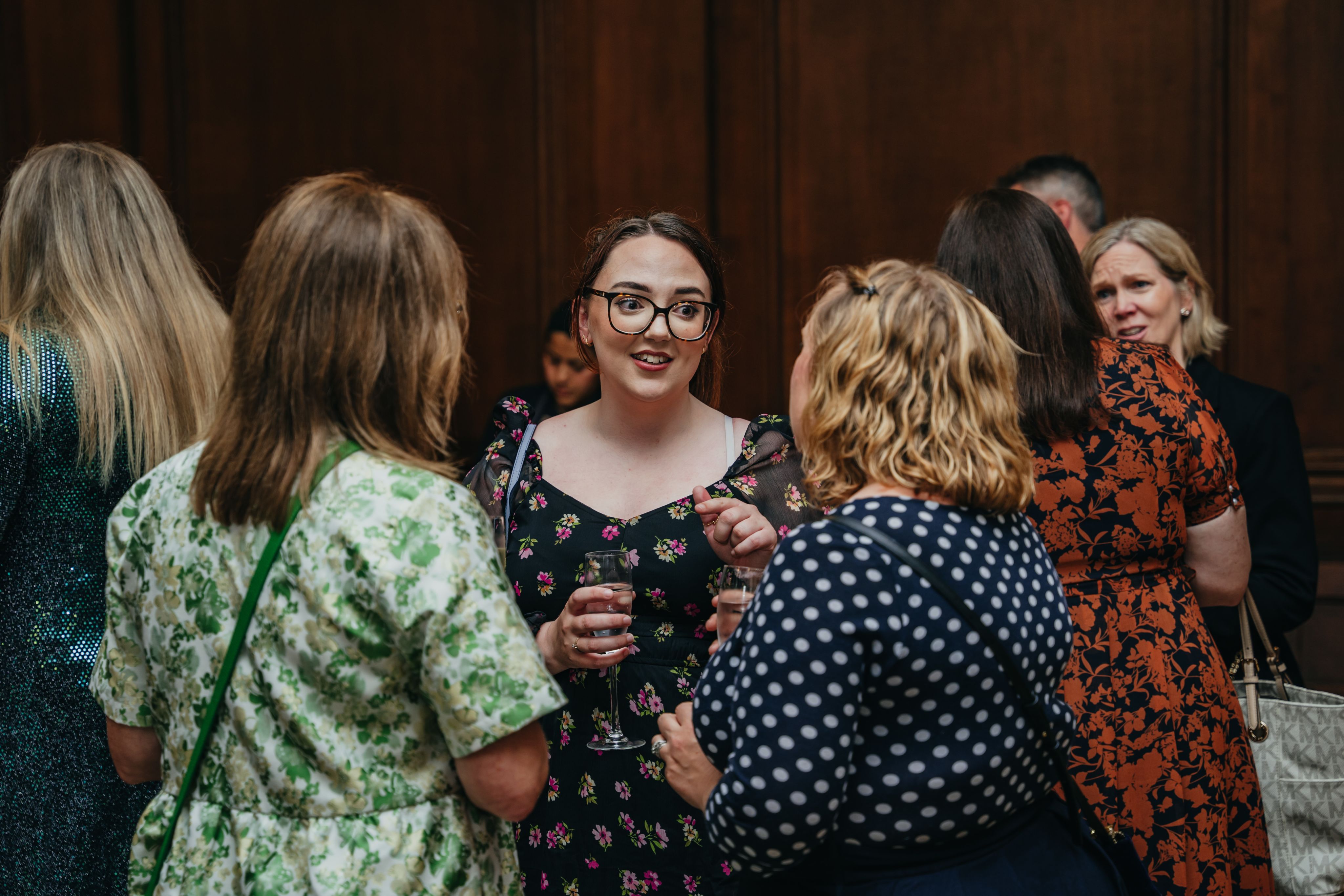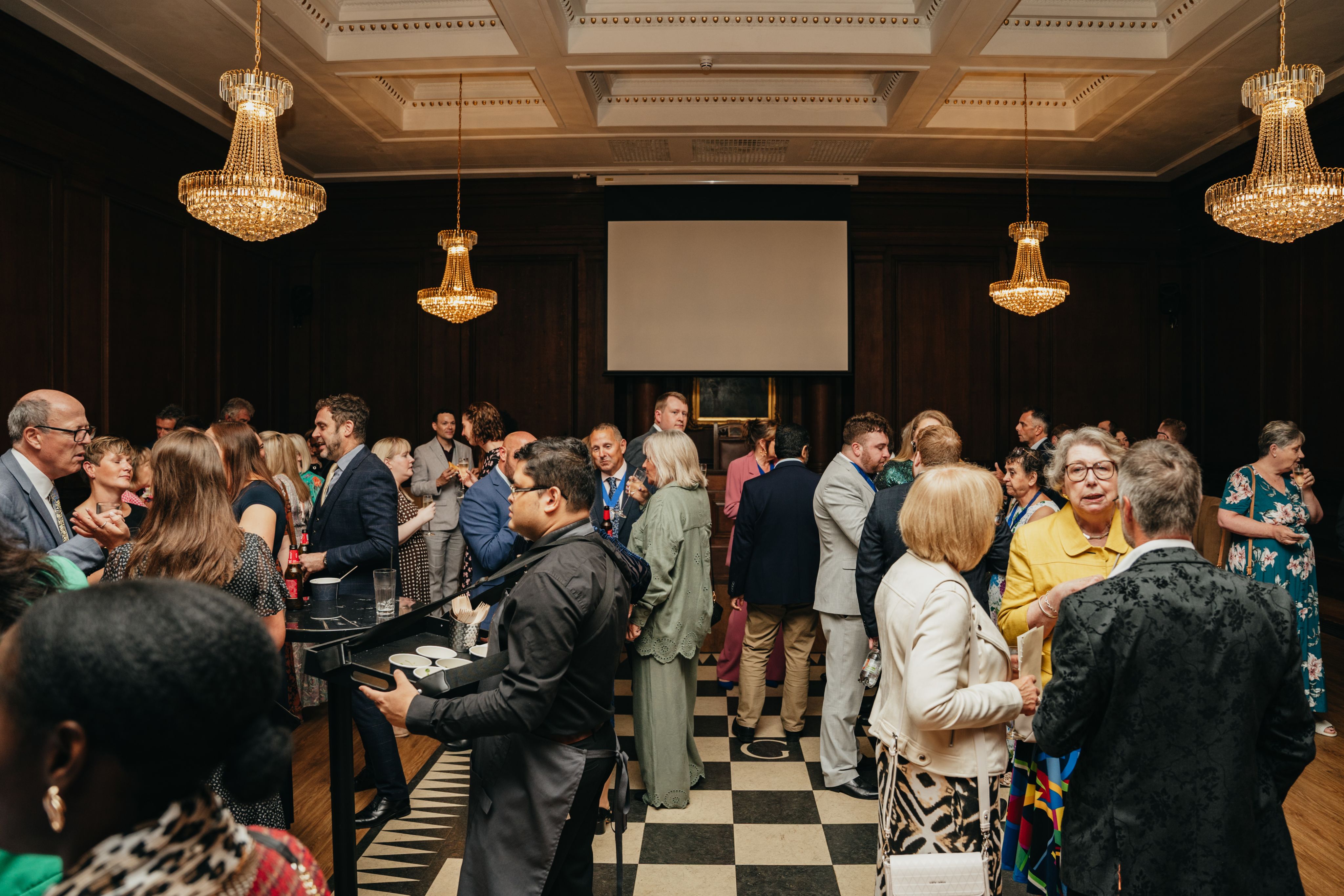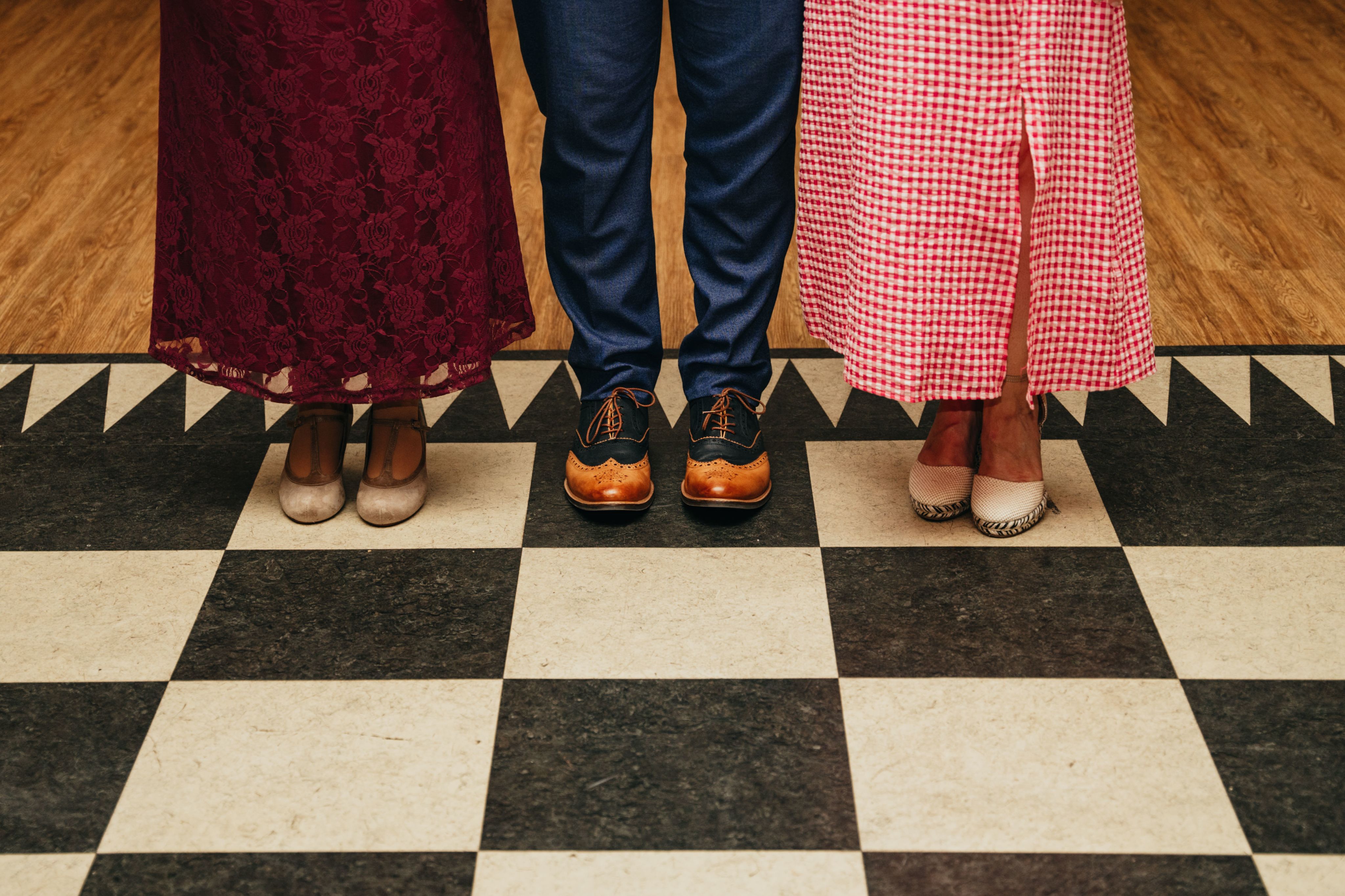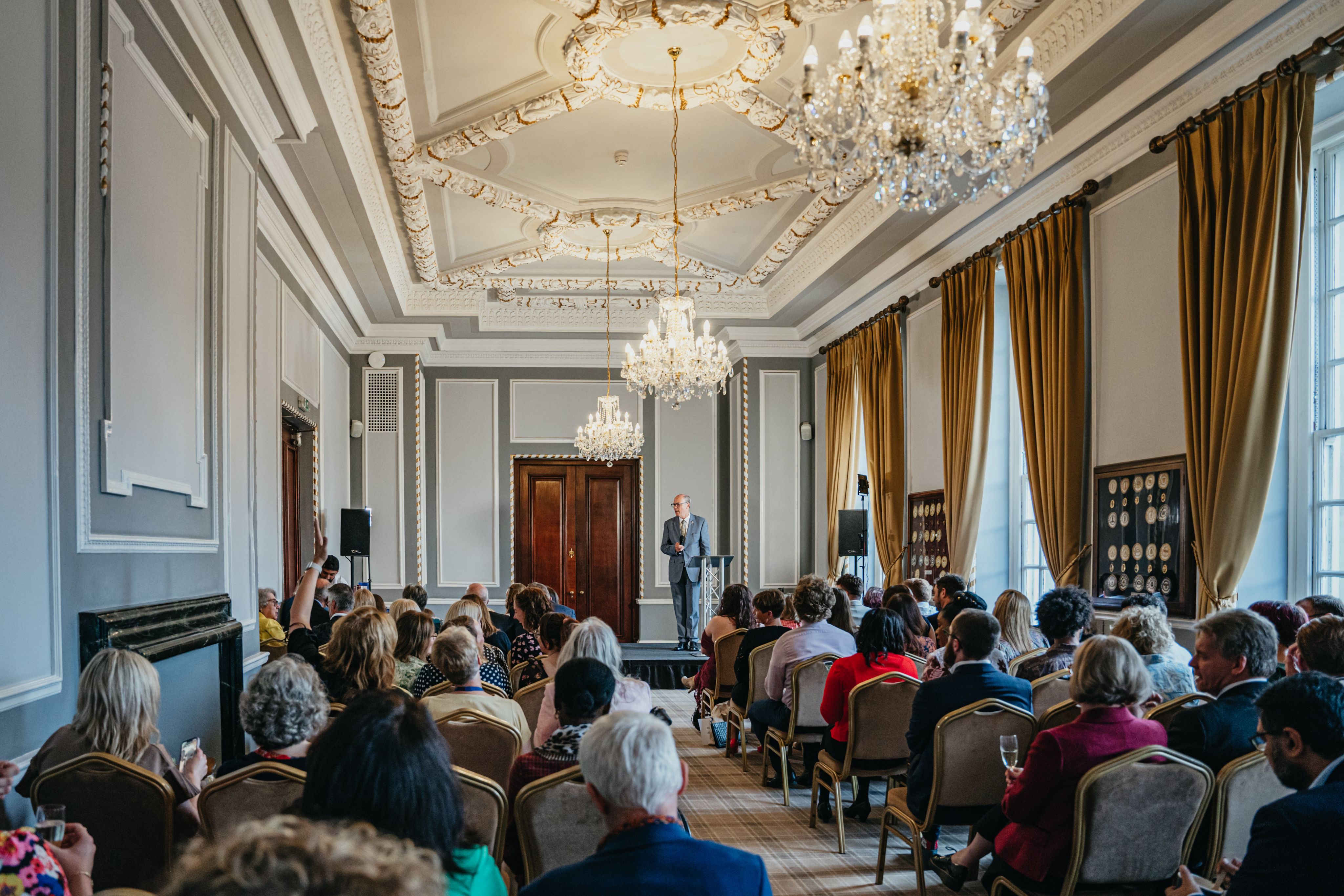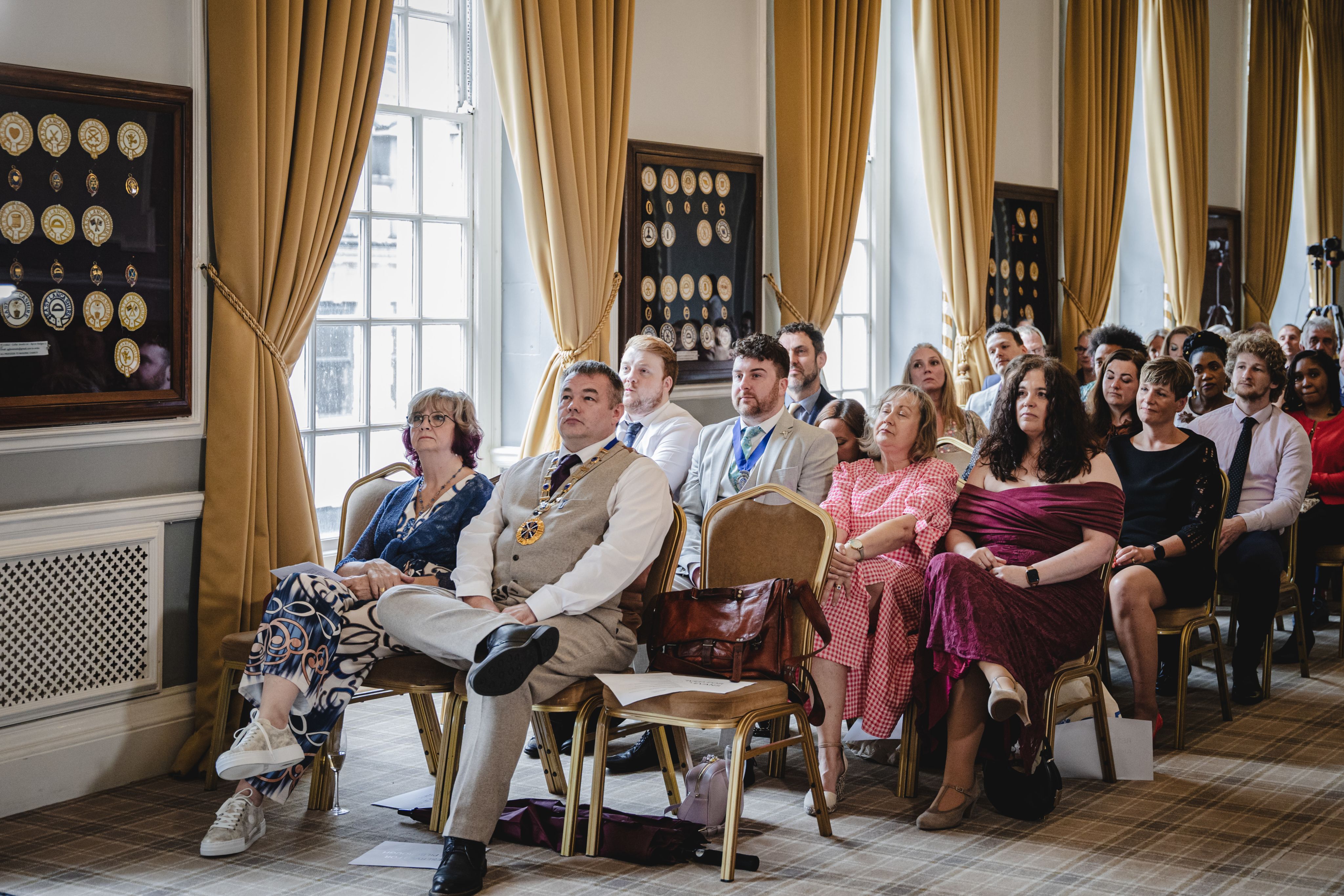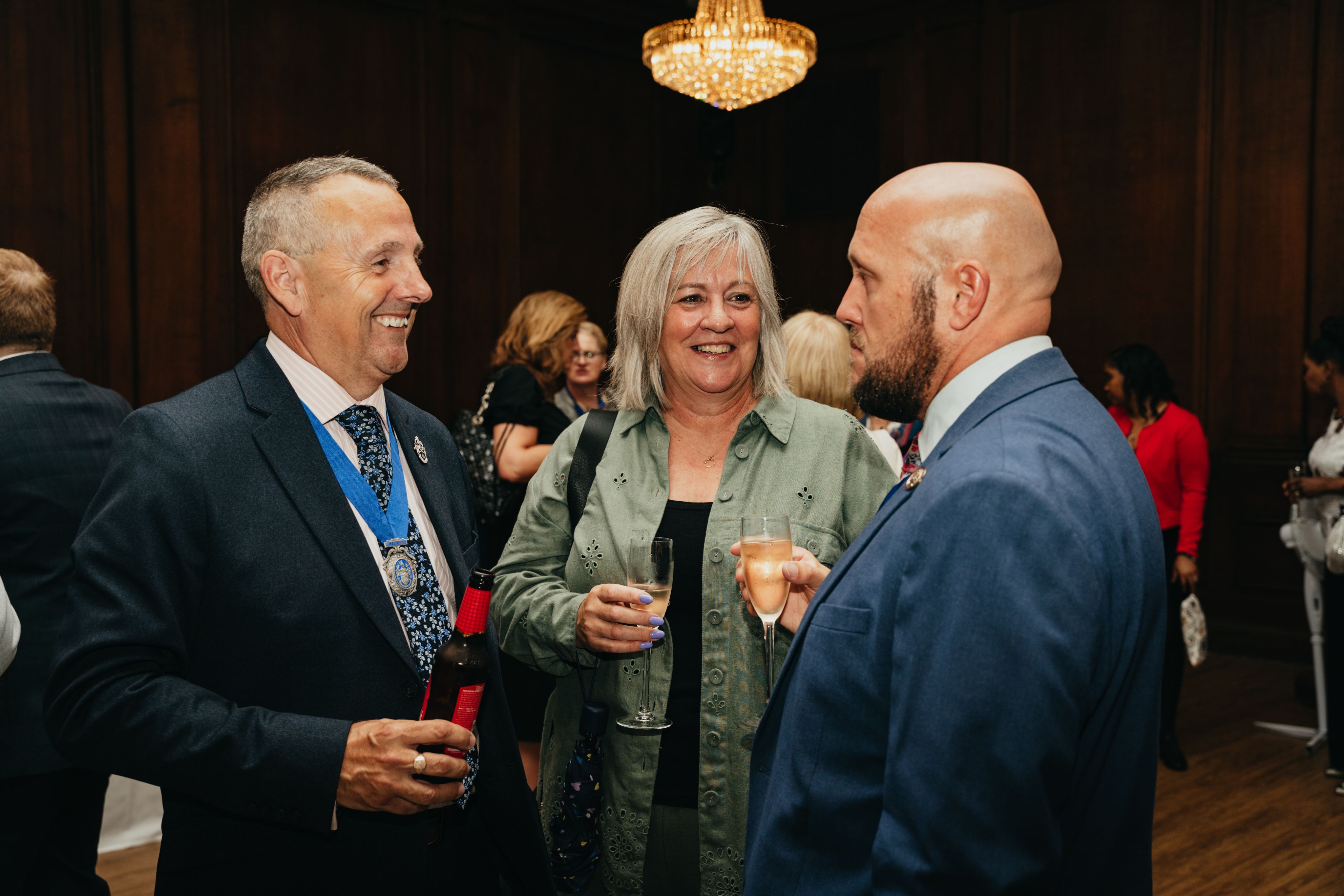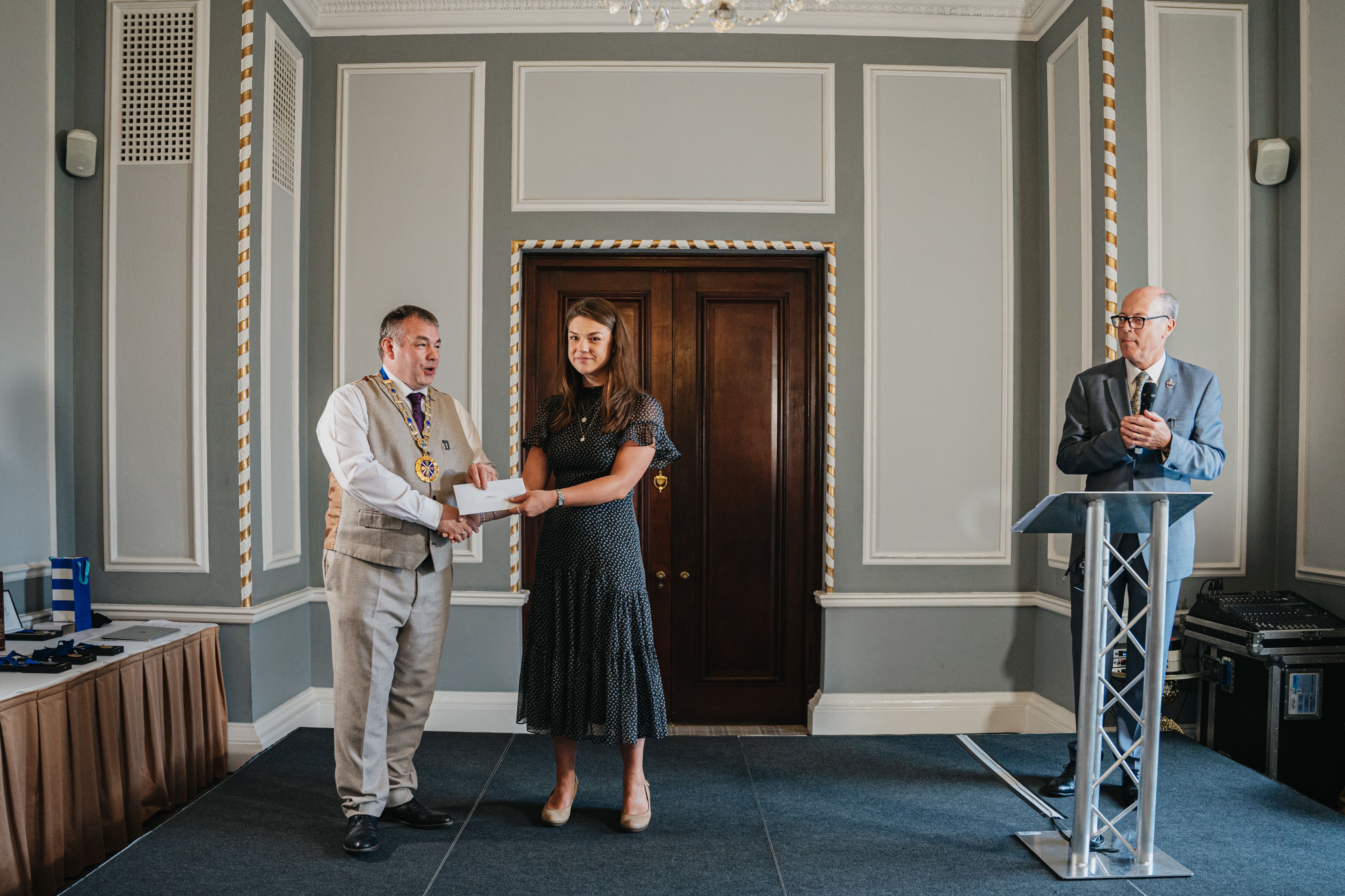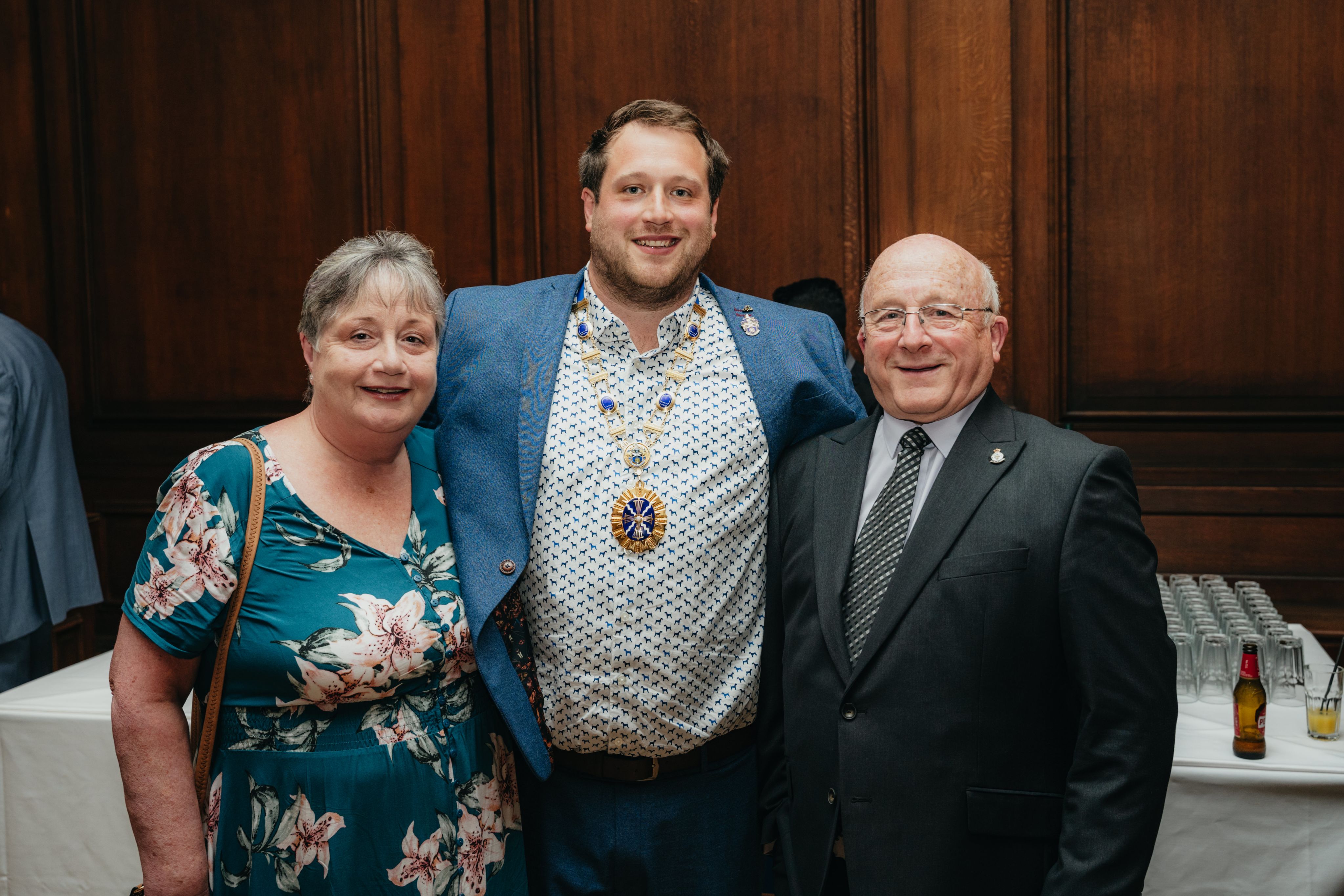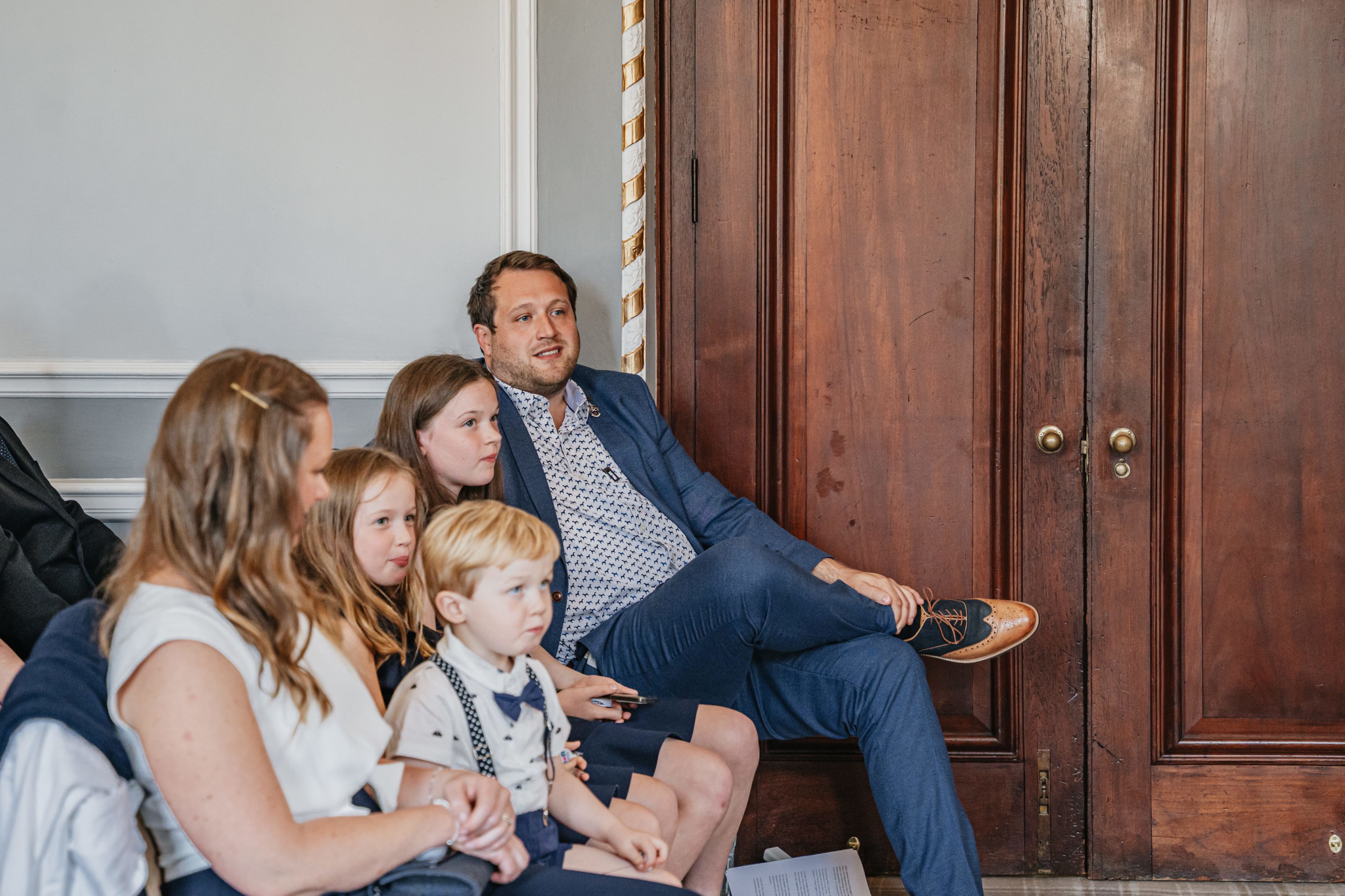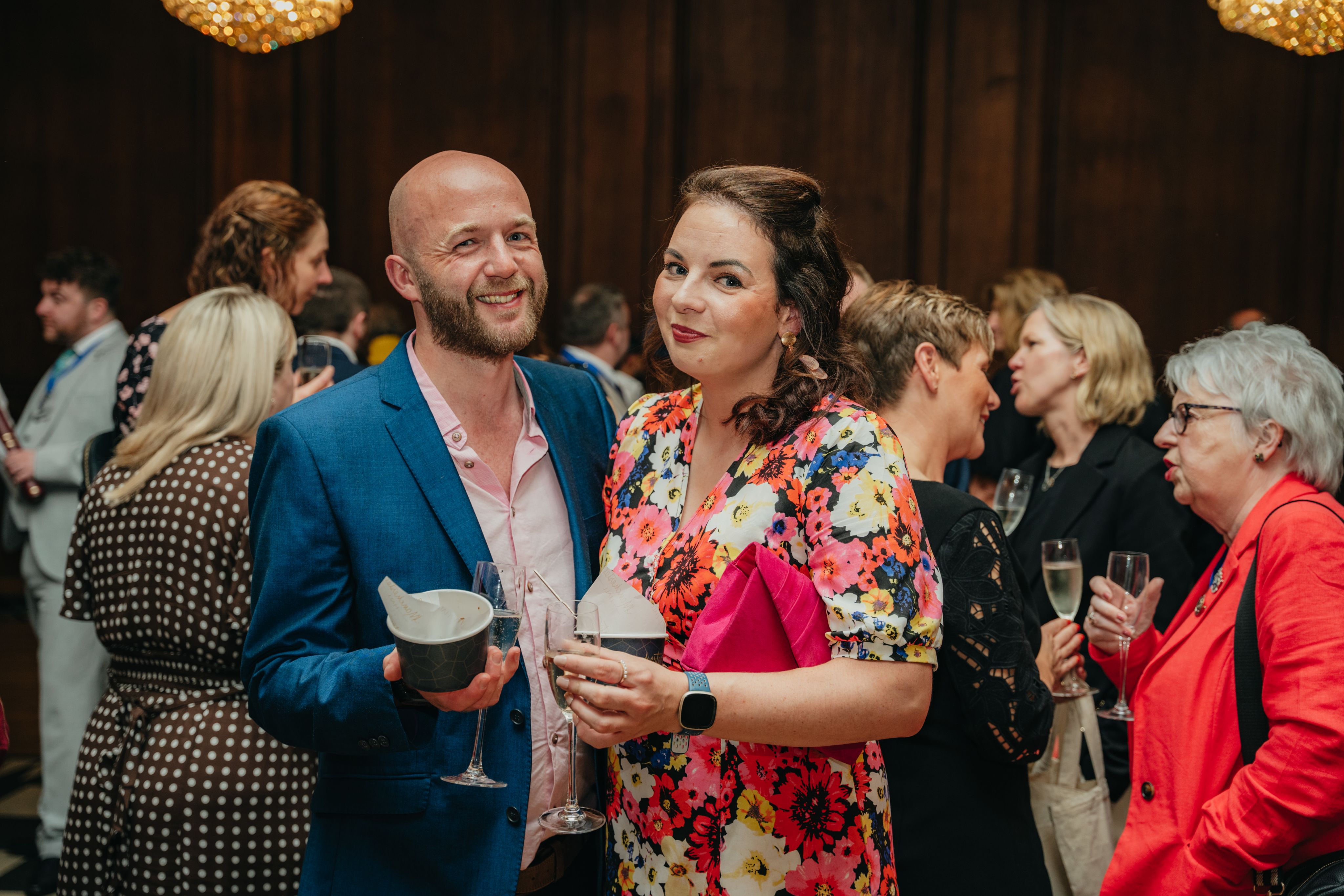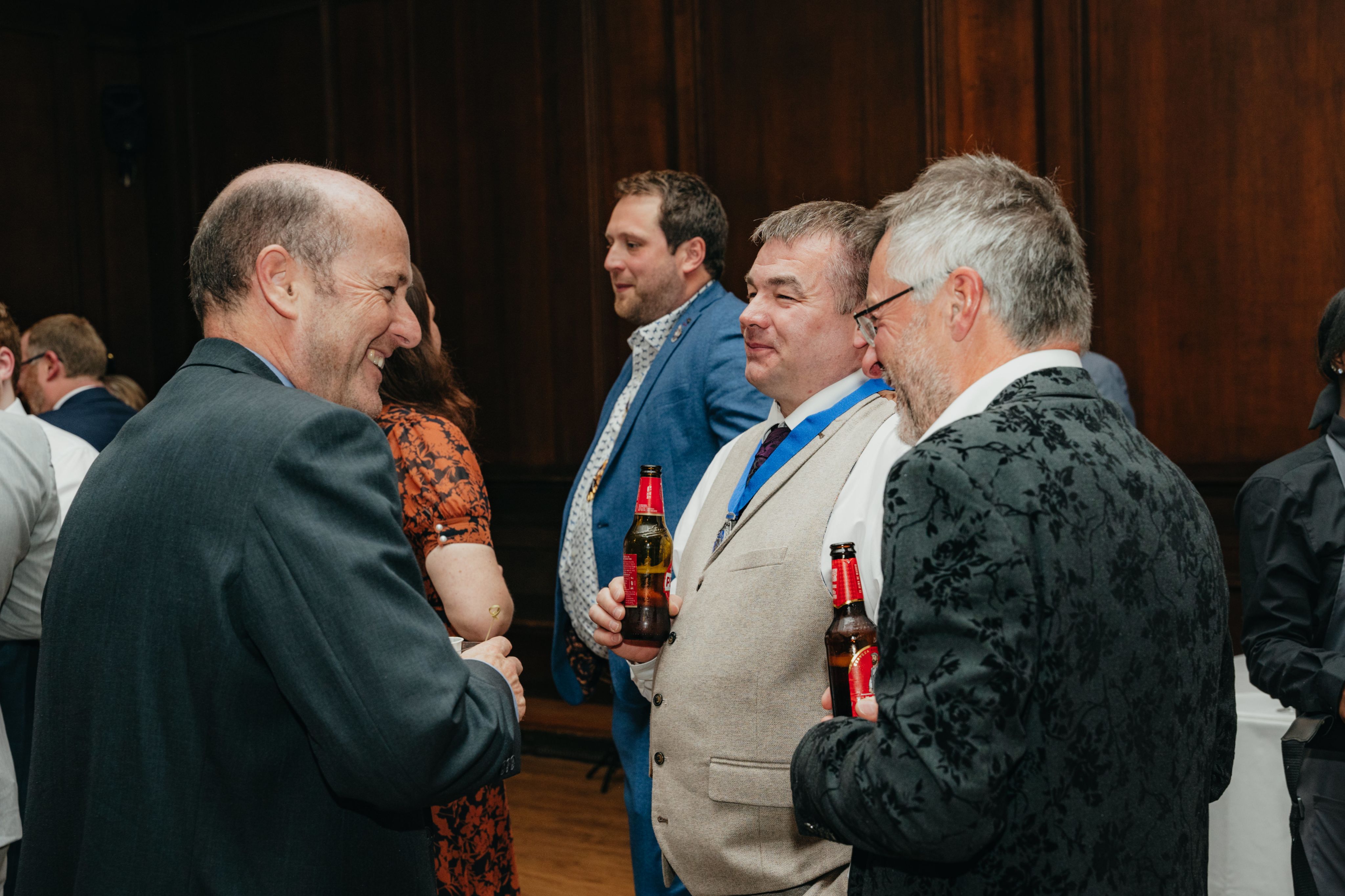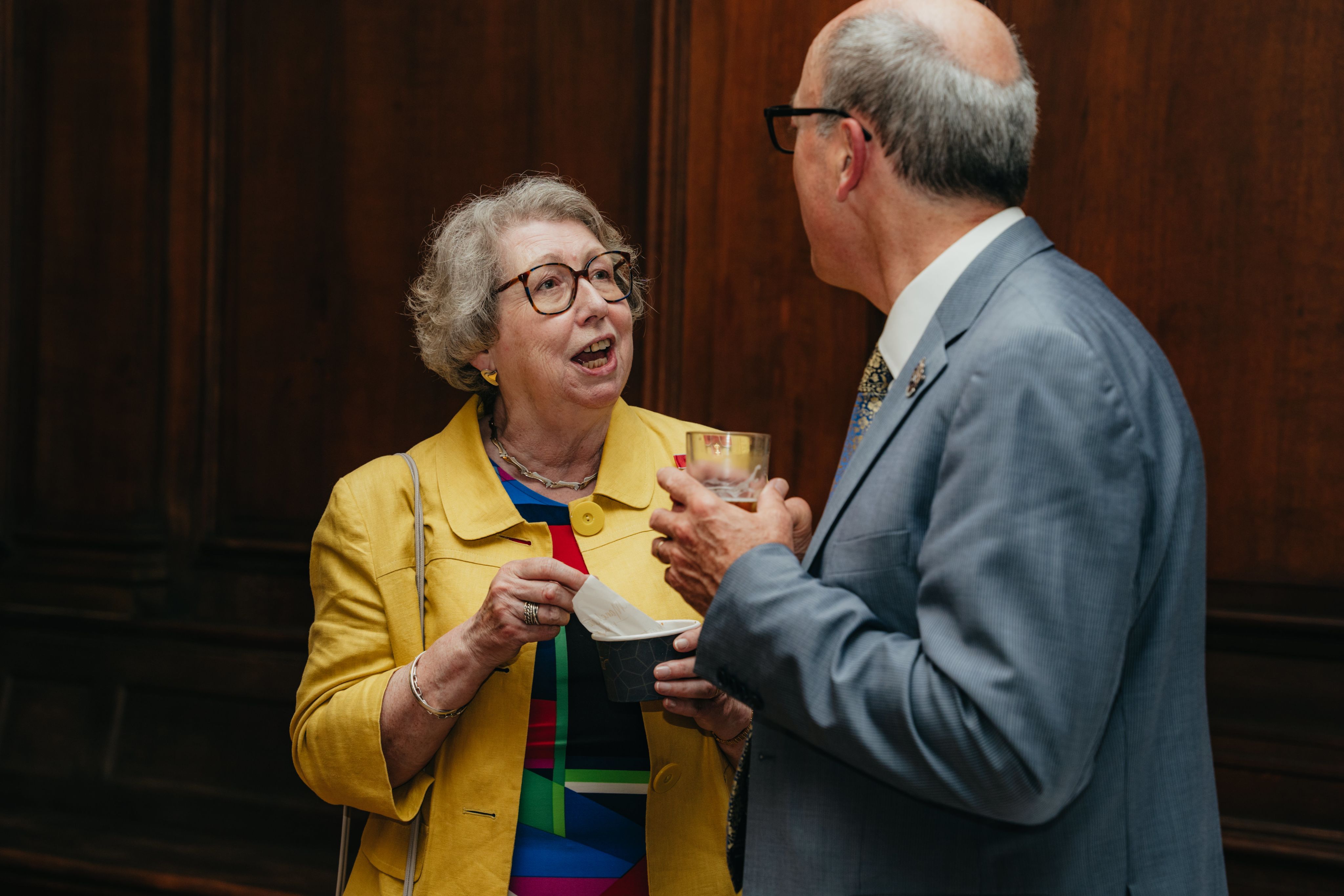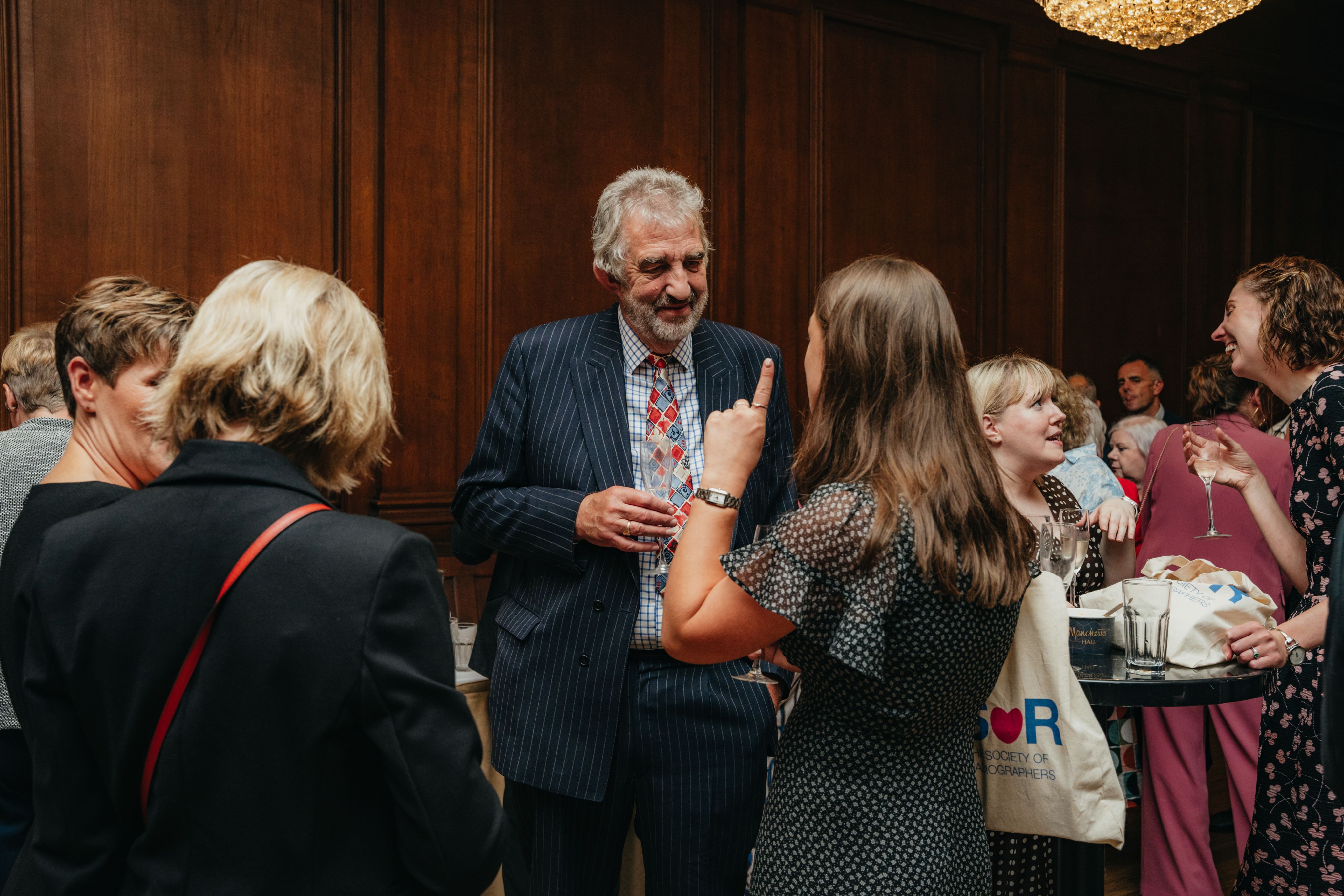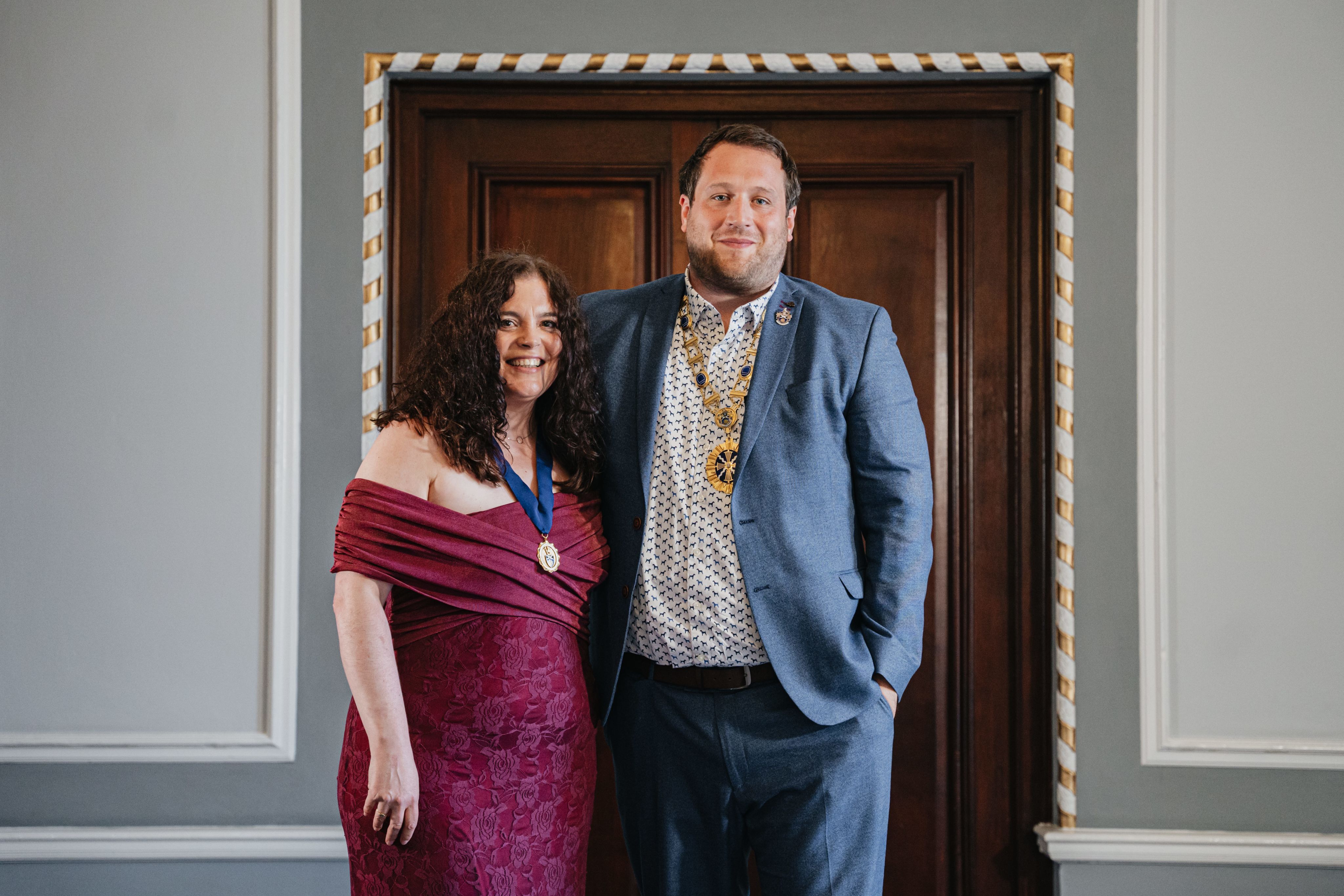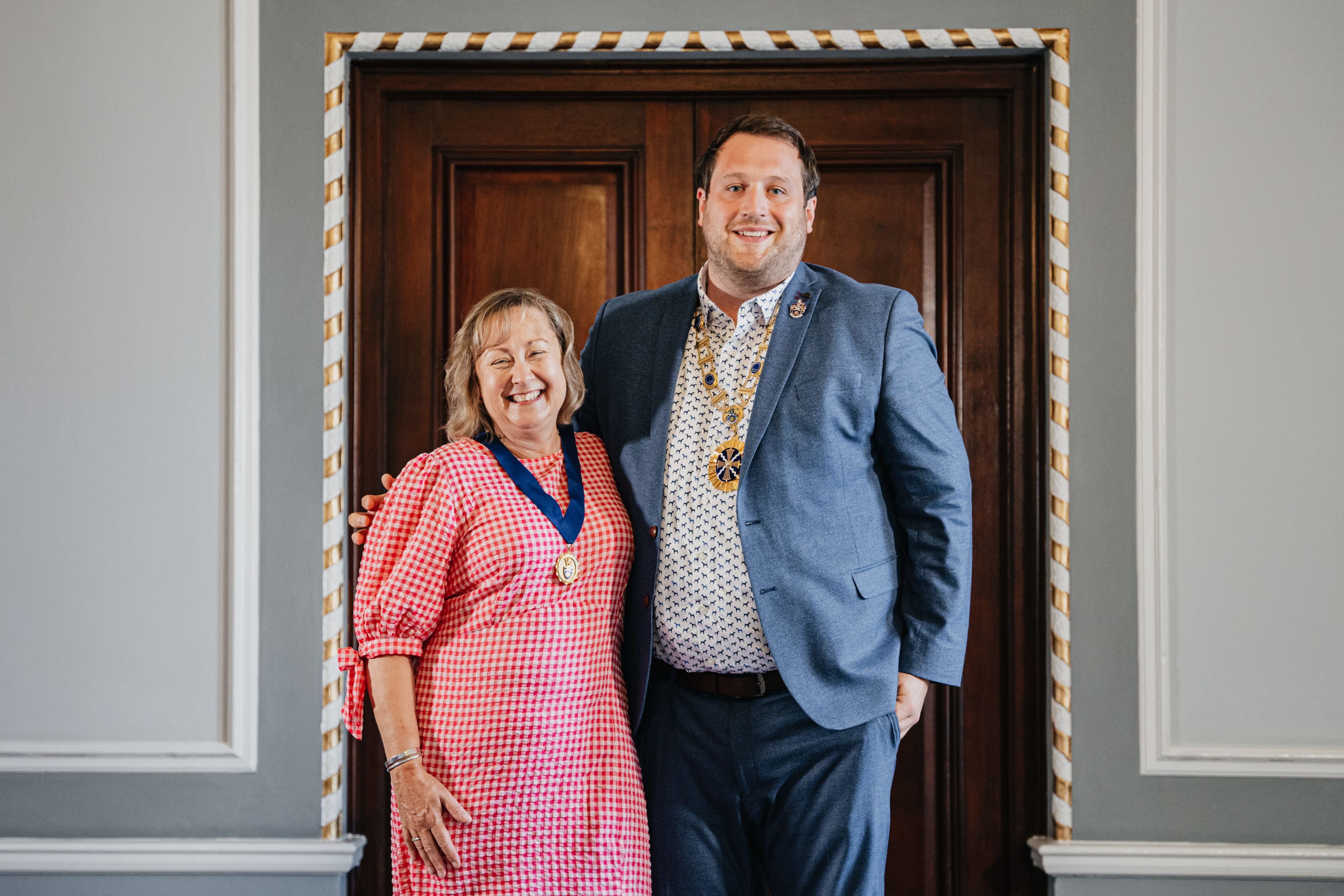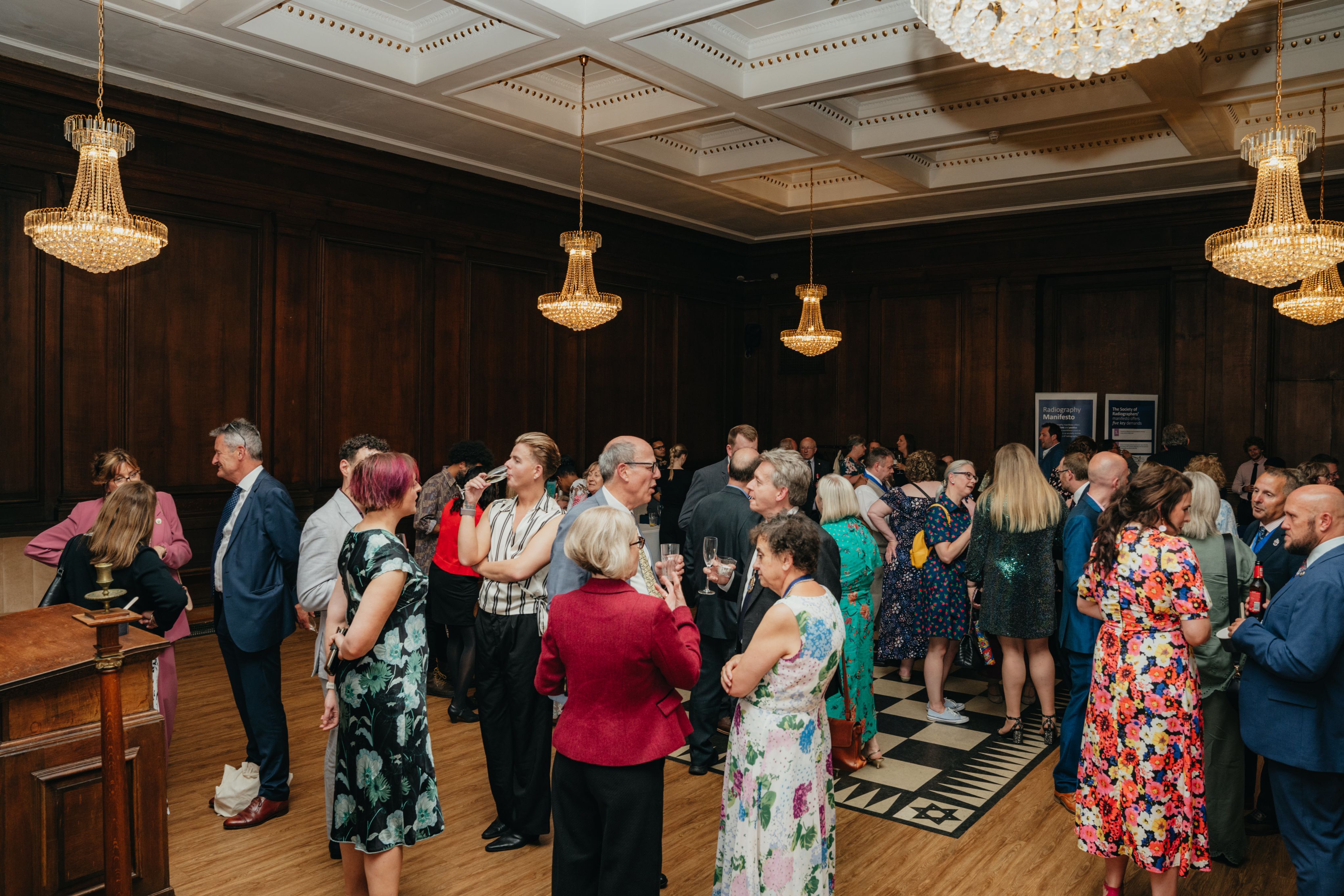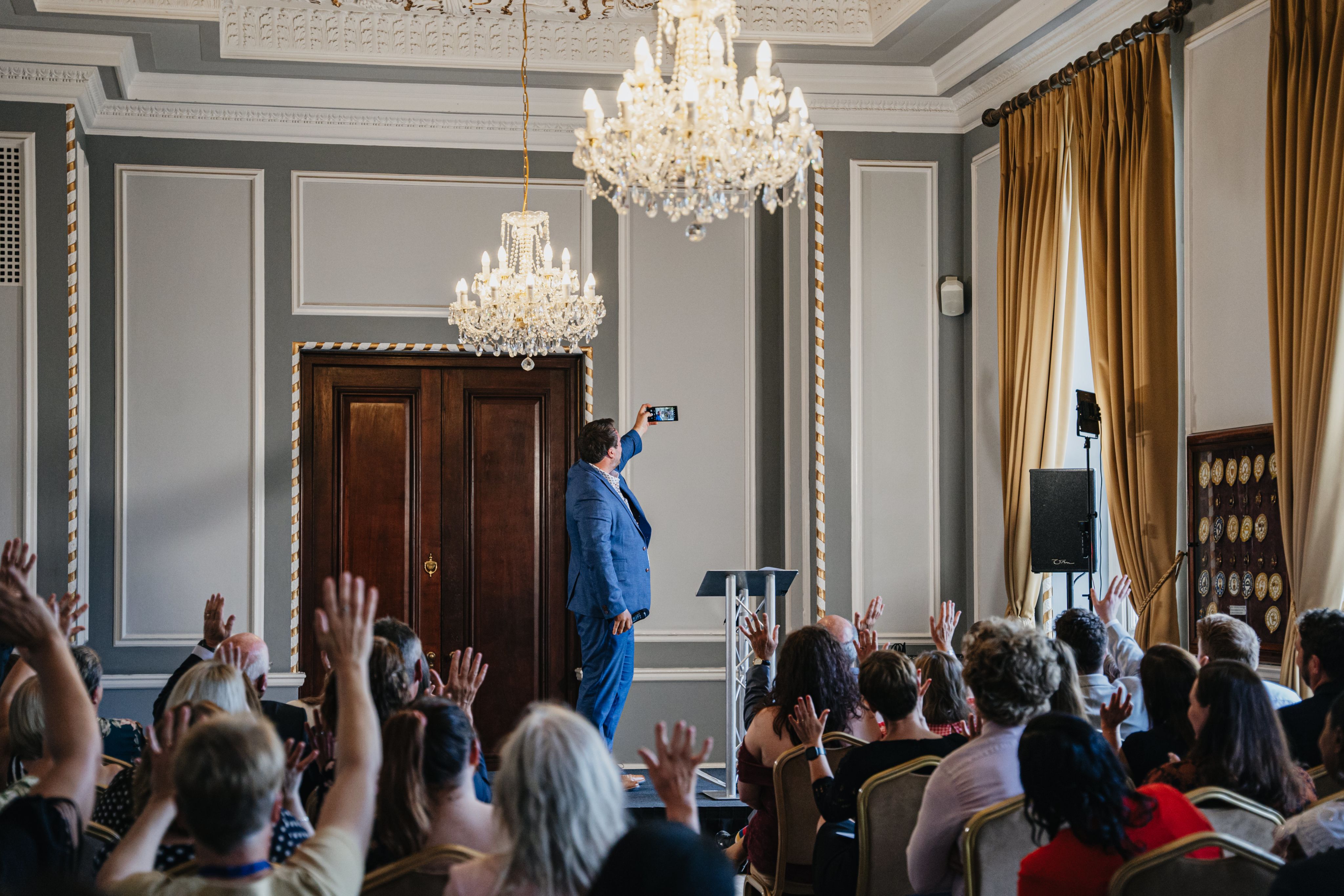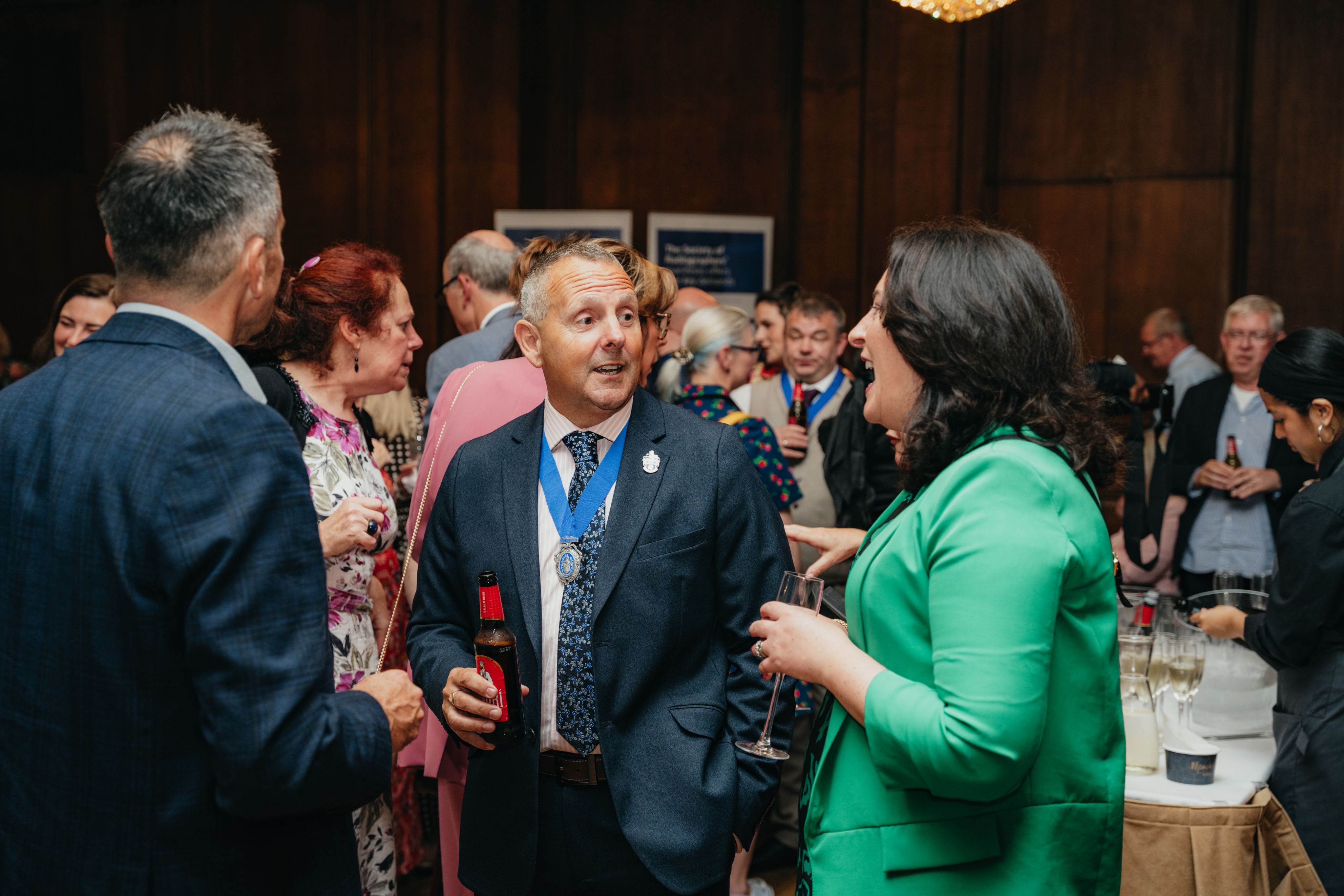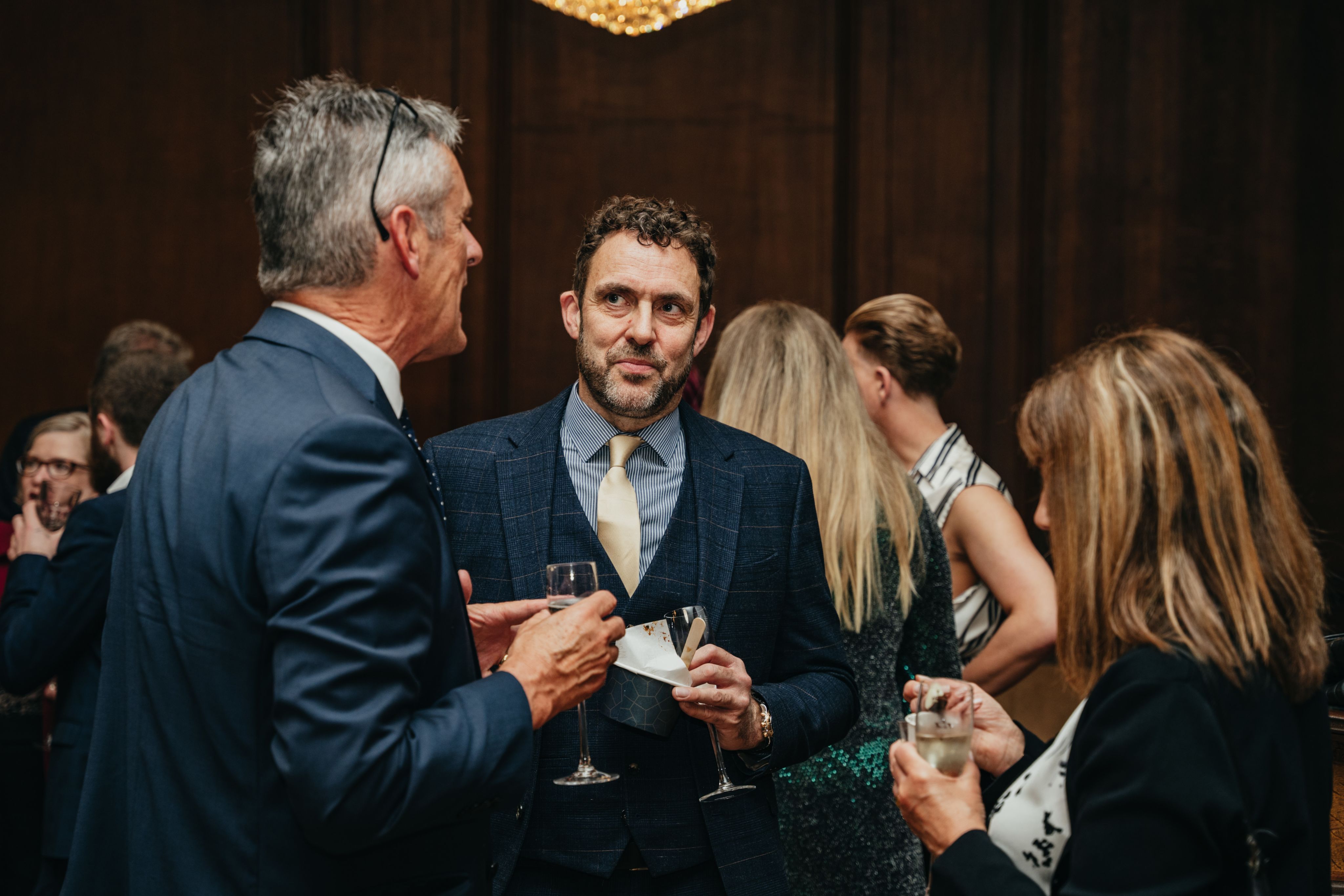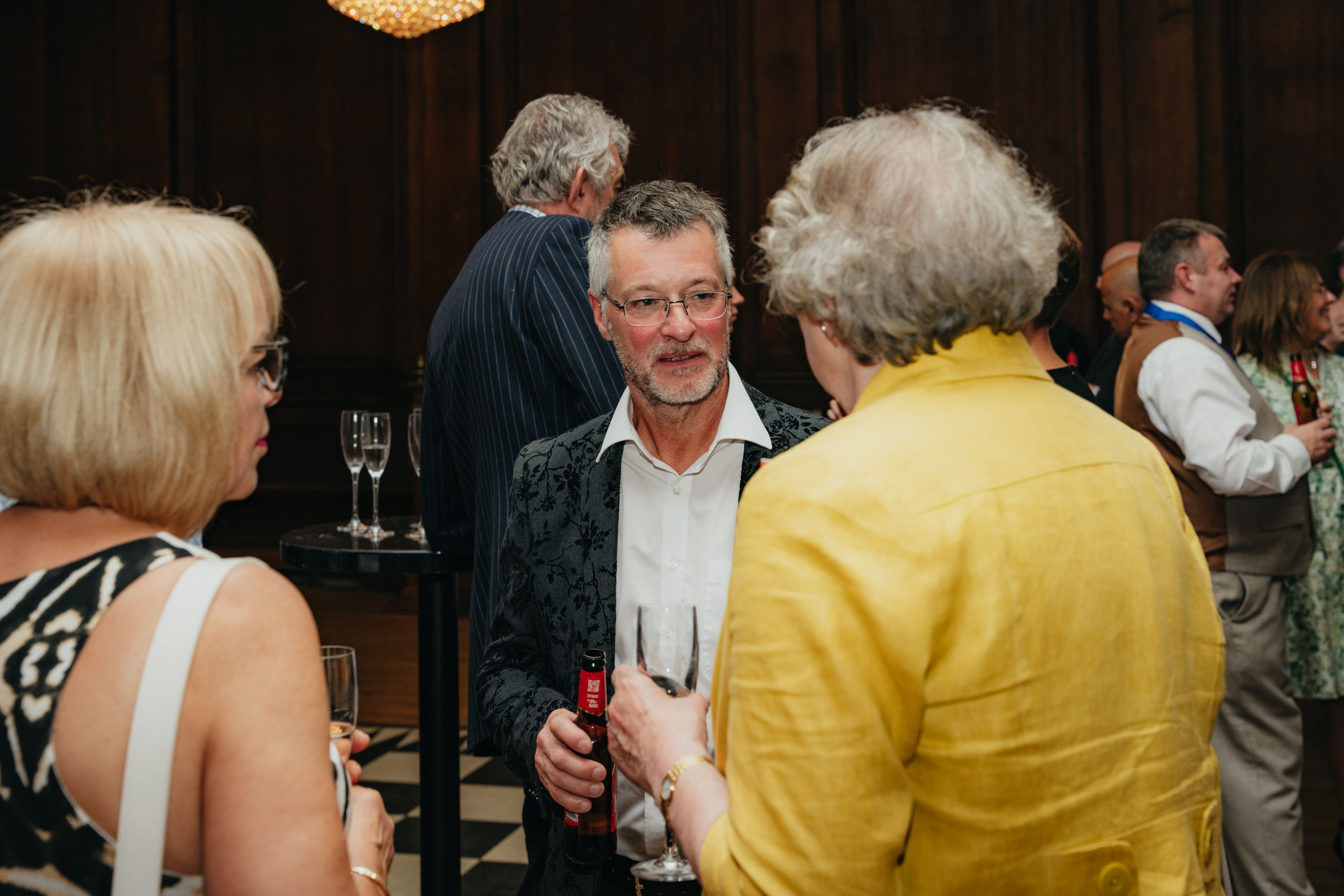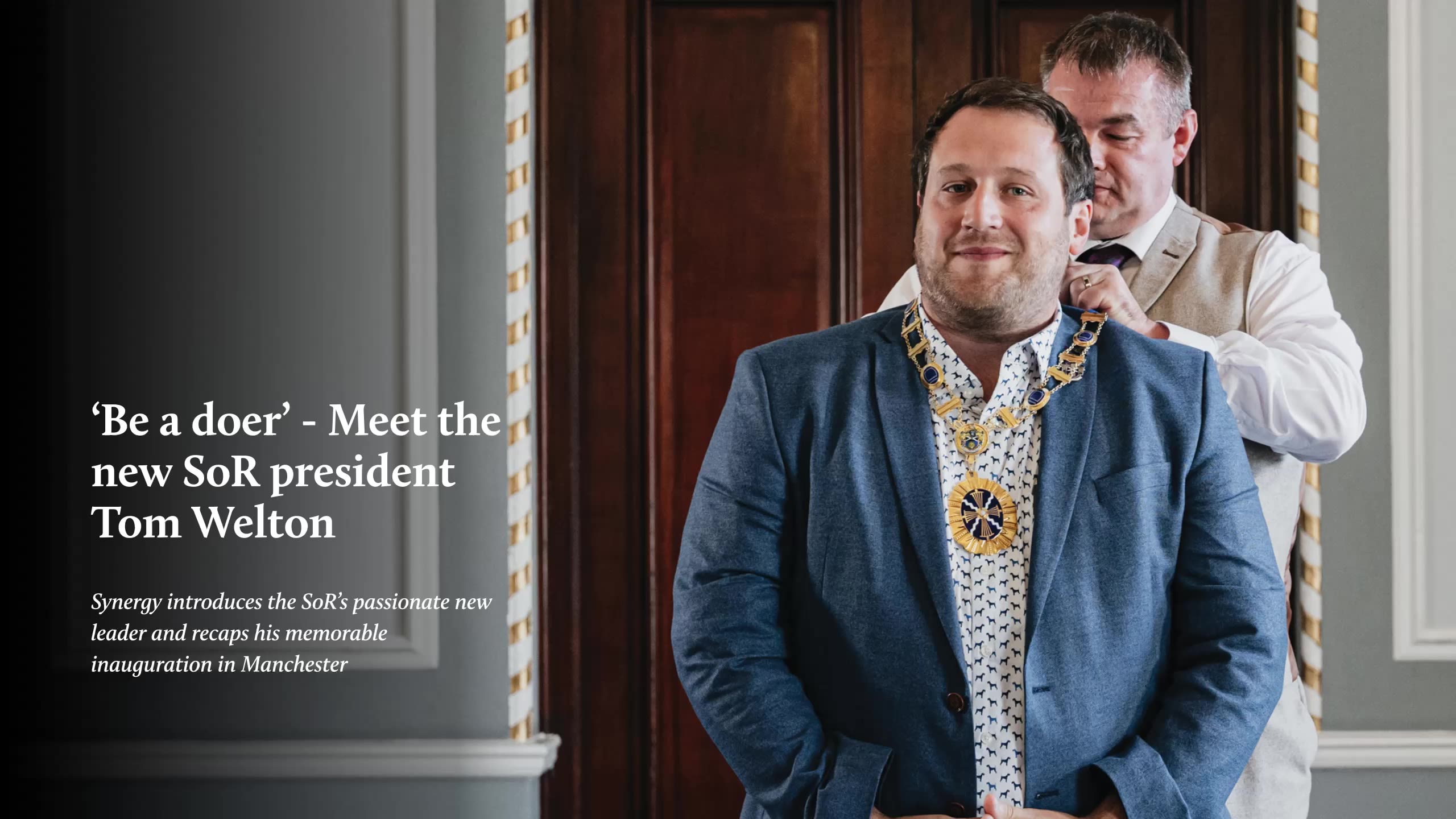
The role of president of the Society of Radiographers is far more than a ceremonial figurehead – and that suits incomer Tom Welton down to the ground.
The lead practice educator for the pre-registration diagnostic radiography programme at Lancashire Teaching Hospital is cheerful, exuberant and full of insight.
His background as an SoR local representative and educator is obvious when you meet him, and he's happy to discuss his interests outside the profession, including sport, animals and the outdoors. But equally, his drive to put in the hard yards to improve conditions for his fellow radiographers shines through.
Synergy spent time with Tom to find out what makes him tick, and hear more about his plans for his new role, including building the profession up to break down the barriers between professionals, and continuing to promote and support the development of the radiography profession.
In this year’s special Synergy presidential inauguration edition, marking the start of Tom’s term as the 87th President of the Society and College of Radiographers, we bring you comprehensive coverage of the ceremony and awards in Manchester, and introduce you to radiography’s leading voice for the next year.
The Society of Radiographers’ presidential inauguration ceremony took place on the evening of Wednesday 3 July at the illustrious Manchester Hall’s Goulborn Lodge in Manchester
Ahead of the inauguration, Synergy spent three days with Tom on a trip to Scotland and took the opportunity to learn more about his journey to the presidency and his ambitious plans.
Introducing
Thomas Welton
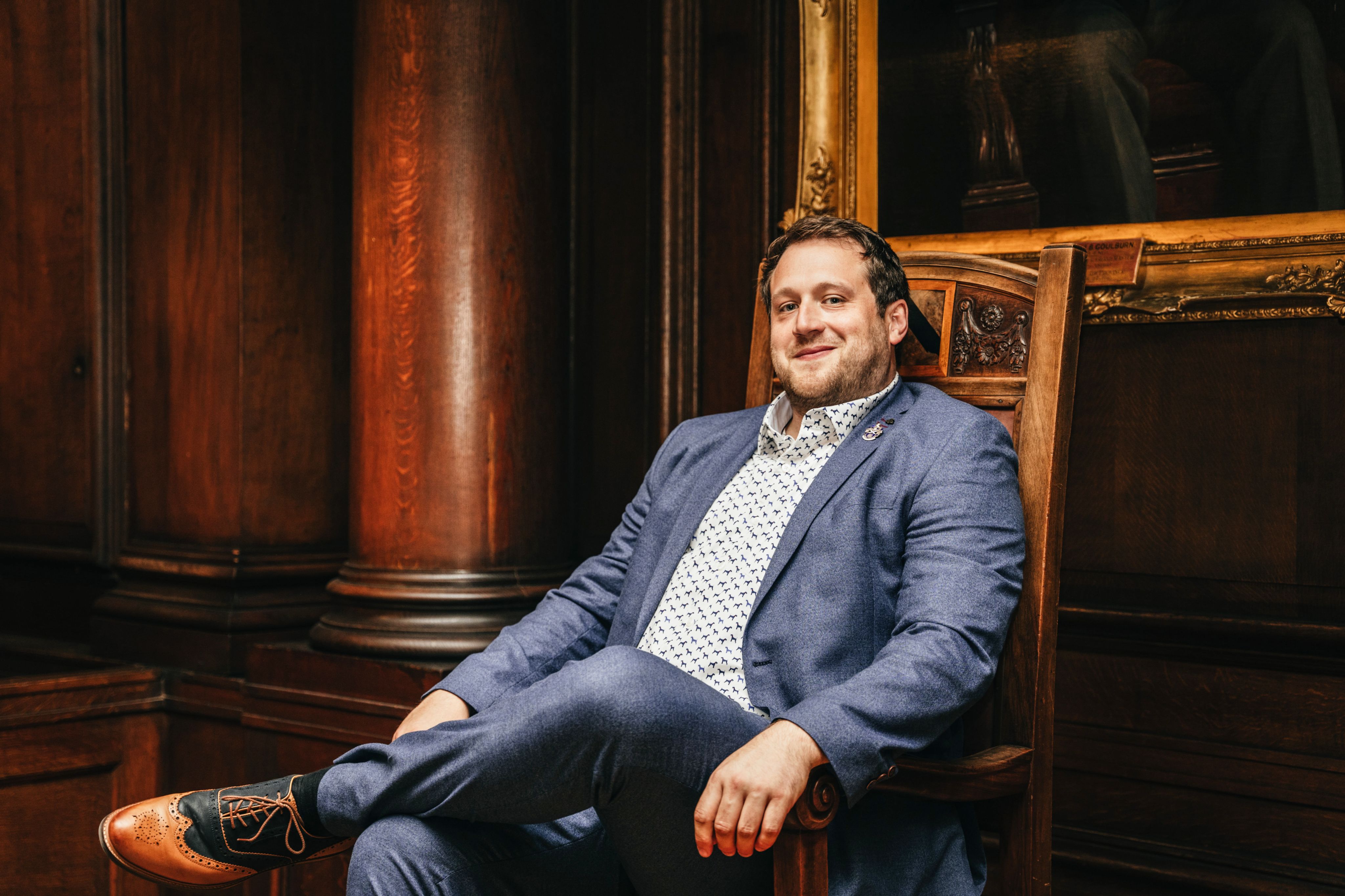
What inspired your interest in radiography?
I started playing rugby when I was eight years old, and as you might imagine, I spent a lot of time in radiology departments due to frequent injuries—broken legs, a hand, toes and fingers. This exposure during my childhood sparked an interest in the field.
I knew I wanted a career that kept me away from a desk. I wasn't interested in sitting in front of a computer all day; I wanted something hands-on. I didn’t see myself in nursing or pursuing medicine, but I was drawn to a technical role that still involved patient care.
Radiography, especially from a diagnostic perspective, perfectly aligned with what I was looking for.
Can you share the key milestones and challenges in your journey as a radiographer?
Honestly, it was a bit of a rough start. I wasn’t the best student and was quite young and naive at 18. Around that time, I was dealing with heart issues, and there was concern I might have 'sudden death syndrome', which led to me taking a year off from university. I couldn’t continue clinical placements because of hypertrophic cardiomyopathy, but thankfully, it turned out I didn’t have the condition. I returned to my studies at Salford University, where I had to buckle down and really focus. It took me five years to complete a three-year course.
I began with an access course for Allied Health Professions at Salford, which gave me a taste of various fields like podiatry, occupational therapy and physiotherapy, alongside radiography. My first job was at Trafford Hospital, where I trained. It’s a small general hospital with an orthopaedic centre, and it was an excellent place to start. The close-knit staff and quick access to CT training were fantastic and I formed lifelong friendships there.
Then I realised, being a young radiographer, I wanted to do a bit more. That’s when I moved closer to where I was living in Wigan, and did four years in CT and MRI at the Wrightington, Wigan and Leigh NHS Foundation Trust.
It wasn’t until I came to Wigan that I actually joined the SoR – stupidly, I hadn’t been in the Society for the first couple of years of my career. Quickly after that, there was an opening to become the union rep in the department, which propelled me forward, and deepened my understanding of our profession.
That gave me a more mature outlook, and from there I became the Council representative for the North West Region. Then I moved to Preston as lead practice educator at Band 7, working with a Band 6, looking after the undergraduates – and now, onto presidency!
What inspired your interest in radiography?
I started playing rugby when I was eight years old, and as you might imagine, I spent a lot of time in radiology departments due to frequent injuries—broken legs, a hand, toes and fingers. This exposure during my childhood sparked an interest in the field.
I knew I wanted a career that kept me away from a desk. I wasn't interested in sitting in front of a computer all day; I wanted something hands-on. I didn’t see myself in nursing or pursuing medicine, but I was drawn to a technical role that still involved patient care.
Radiography, especially from a diagnostic perspective, perfectly aligned with what I was looking for.
Can you share the key milestones and challenges in your journey as a radiographer?
Honestly, it was a bit of a rough start. I wasn’t the best student and was quite young and naive at 18. Around that time, I was dealing with heart issues, and there was concern I might have 'sudden death syndrome', which led to me taking a year off from university. I couldn’t continue clinical placements because of hypertrophic cardiomyopathy, but thankfully, it turned out I didn’t have the condition. I returned to my studies at Salford University, where I had to buckle down and really focus. It took me five years to complete a three-year course.
I began with an access course for Allied Health Professions at Salford, which gave me a taste of various fields like podiatry, occupational therapy and physiotherapy, alongside radiography. My first job was at Trafford Hospital, where I trained. It’s a small general hospital with an orthopaedic centre, and it was an excellent place to start. The close-knit staff and quick access to CT training were fantastic and I formed lifelong friendships there.
Then I realised, being a young radiographer, I wanted to do a bit more. That’s when I moved closer to where I was living in Wigan, and did four years in CT and MRI at the Wrightington, Wigan and Leigh NHS Foundation Trust.
It wasn’t until I came to Wigan that I actually joined the SoR – stupidly, I hadn’t been in the Society for the first couple of years of my career. Quickly after that, there was an opening to become the union rep in the department, which propelled me forward, and deepened my understanding of our profession.
That gave me a more mature outlook, and from there I became the Council representative for the North West Region. Then I moved to Preston as lead practice educator at Band 7, working with a Band 6, looking after the undergraduates – and now, onto presidency!
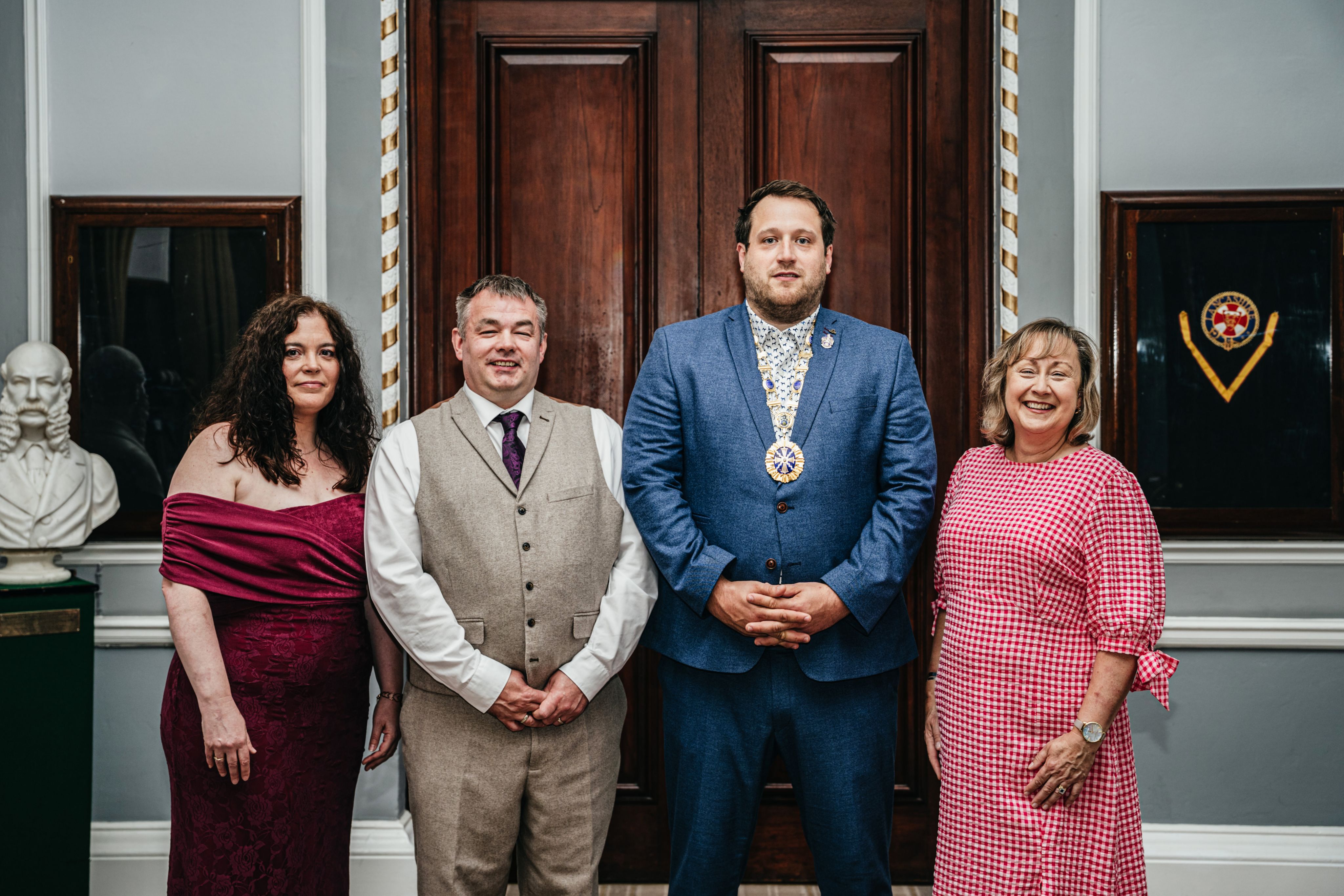
How has your involvement with the Society of Radiographers shaped your career?
Initially, I didn’t join the SoR out of sheer naivety. I wasn’t aware of its role or significance and no one around me was really explaining it. Once I did join, however, it was a game-changer. When I was elected president, I immediately felt a sense of impostor syndrome, wondering what I had gotten myself into, but it was the natural next step in my journey.
I didn’t join the Council with the intention of becoming president; I joined for the opportunity to contribute. I thoroughly enjoy being on the Council, so stepping up to the presidency felt like the right move. Thankfully, I was voted in!
I often encourage others to be proactive, to be the ones who initiate change rather than just follow directions. I enjoy being in a position where I can influence and give back, and the presidency gives me a year to work with my colleagues to make meaningful change for our members and the profession.
How has your involvement with the Society of Radiographers shaped your career?
Initially, I didn’t join the SoR out of sheer naivety. I wasn’t aware of its role or significance and no one around me was really explaining it. Once I did join, however, it was a game-changer. When I was elected president, I immediately felt a sense of impostor syndrome, wondering what I had gotten myself into, but it was the natural next step in my journey.
I didn’t join the Council with the intention of becoming president; I joined for the opportunity to contribute. I thoroughly enjoy being on the Council, so stepping up to the presidency felt like the right move. Thankfully, I was voted in!
I often encourage others to be proactive, to be the ones who initiate change rather than just follow directions. I enjoy being in a position where I can influence and give back, and the presidency gives me a year to work with my colleagues to make meaningful change for our members and the profession.
What are you most excited about and what challenges do you expect in the coming year?
The biggest challenge will be the toll it takes on my time, especially being away from my family, including my three young children. That’s going to be tough.
What I’m really looking forward to, because I’m a big believer in it, is communication and networking, getting out there and meeting new people.
It’s a bit of a cliche, but that’s the part I really enjoy. I like having a chat with people, I like understanding people’s points of view, talking things through. It’s that access to areas I would never normally reach to.
Especially from a radiotherapy point of view – we’ve got Rosemere Cancer Centre at Preston Hospital, and getting to know the Therapeutic Radiographers down there has been lovely. Understanding the radiotherapy profession nationally, and getting more exposure to those areas, would be fantastic.
What are you most excited about and what challenges do you expect in the coming year?
The biggest challenge will be the toll it takes on my time, especially being away from my family, including my three young children. That’s going to be tough.
What I’m really looking forward to, because I’m a big believer in it, is communication and networking, getting out there and meeting new people.
It’s a bit of a cliche, but that’s the part I really enjoy. I like having a chat with people, I like understanding people’s points of view, talking things through. It’s that access to areas I would never normally reach to.
Especially from a radiotherapy point of view – we’ve got Rosemere Cancer Centre at Preston Hospital, and getting to know the Therapeutic Radiographers down there has been lovely. Understanding the radiotherapy profession nationally, and getting more exposure to those areas, would be fantastic.
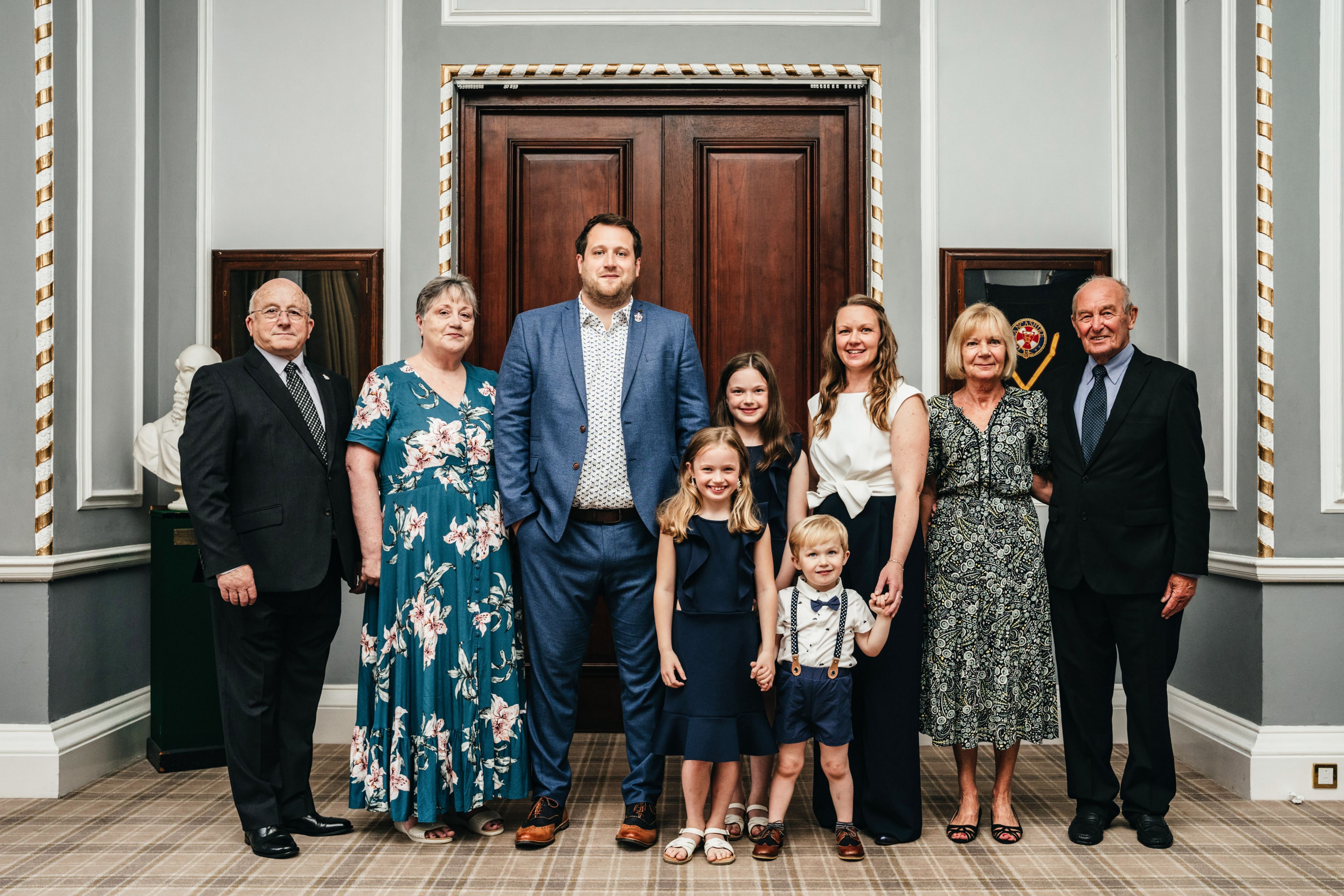
What are your most immediate priorities?
I have a couple of main objectives, both internally and externally focused. One is on careers and outreach—raising awareness in schools and colleges about who radiographers are and what they do, to encourage more people to join the profession. This will be a strong theme throughout the year.
Another focus is on networks and communication structures. I want to understand how our various sets of amazing volunteers—be it in the reps networks, managers' networks, regional committees, student groups, or advisory groups—communicate and discuss changes. I aim to address any bottlenecks, especially in this post-Covid world where communication structures have evolved with video calls on platforms like Microsoft Teams and Zoom. Collaborating with the staff to improve this structure will be beneficial.
Internally, like any board of directors, it's crucial to understand the Society’s role and make financially sound decisions to ensure we continue to spend membership money wisely and effectively. Funds are limited, and tough decisions are sometimes necessary, so ensuring value for money is paramount. It's also vital that members recognise this value.
Our entire identity revolves around the Society and the College of Radiographers—we are the professional voice for radiographers and the radiography workforce. We must raise our profile externally and make the nation aware that we are a formidable force.
What are your most immediate priorities?
I have a couple of main objectives, both internally and externally focused. One is on careers and outreach—raising awareness in schools and colleges about who radiographers are and what they do, to encourage more people to join the profession. This will be a strong theme throughout the year.
Another focus is on networks and communication structures. I want to understand how our various sets of amazing volunteers—be it in the reps networks, managers' networks, regional committees, student groups, or advisory groups—communicate and discuss changes. I aim to address any bottlenecks, especially in this post-Covid world where communication structures have evolved with video calls on platforms like Microsoft Teams and Zoom. Collaborating with the staff to improve this structure will be beneficial.
Internally, like any board of directors, it's crucial to understand the Society’s role and make financially sound decisions to ensure we continue to spend membership money wisely and effectively. Funds are limited, and tough decisions are sometimes necessary, so ensuring value for money is paramount. It's also vital that members recognise this value.
Our entire identity revolves around the Society and the College of Radiographers—we are the professional voice for radiographers and the radiography workforce. We must raise our profile externally and make the nation aware that we are a formidable force.
What is your message to the membership?
We all need to vent from time to time; it's natural and can even be good for the soul. But there’s a point where too much complaining holds us back—it can drag down teams, departments, even entire organisations.
What we need now are fewer complainers and more action-takers. Don’t just talk about the problems; be part of the solution. Engage with your regional committees, your reps networks, your managers, and student groups. Take action.
The Society of Radiographers is accessible to everyone, at every level. I’m not extraordinary—I started as a typical radiographer and worked my way up through Bands 5, 6, and 7 to become president, simply by getting involved and making my voice heard.
So instead of sitting back and asking, "What have they ever done for me?" take the initiative. I won UK Rep of the Year in 2018 because I chose to be an active member of the SoR. That’s all it takes—engagement and action.
As a profession, we need to continue shining a light on our work and proudly showcase who we are. Let’s push forward together and make our mark.
What is your message to the membership?
We all need to vent from time to time; it's natural and can even be good for the soul. But there’s a point where too much complaining holds us back—it can drag down teams, departments, even entire organisations.
What we need now are fewer complainers and more action-takers. Don’t just talk about the problems; be part of the solution. Engage with your regional committees, your reps networks, your managers, and student groups. Take action.
The Society of Radiographers is accessible to everyone, at every level. I’m not extraordinary—I started as a typical radiographer and worked my way up through Bands 5, 6, and 7 to become president, simply by getting involved and making my voice heard.
So instead of sitting back and asking, "What have they ever done for me?" take the initiative. I won UK Rep of the Year in 2018 because I chose to be an active member of the SoR. That’s all it takes—engagement and action.
As a profession, we need to continue shining a light on our work and proudly showcase who we are. Let’s push forward together and make our mark.
The Presidential Awards Ceremony
During the SoR’s presidential inauguration on Wednesday 3 July, winners in a variety of awards categories were presented with their medals and certificates. The inauguration held at Manchester Hall’s Goulborn Lodge in Manchester celebrated the passing of the torch from Dave Pilborough to 87th president Tom Welton. Alongside CEO Richard Evans, Mr Pilborough and Mr Welton presented awards to members of the SoR.
The College of Radiographers Fellowship, which recognises outstanding contributions to the profession of radiography and the advancement of the Society of Radiographers, was awarded to radiographer Peter Sharpe.
The College of Radiographers Fellowship was also awarded to past SoR president Therapeutic Radiographer Ross McGhee.
The Silver Medal of the Society of Radiographers was presented to Dianne Hogg, for significant contributions to the profession.
The Forder Memorial Award, celebrating the best paper proffered by a student, is given in memory of a founder of the SoR and member of the first Council of the Society – this year’s winner was Poppy Ulett.
The Alan Nichols Memorial Award is given to the best paper proffered by a radiographer, and was won by both Amy Hancock and Naman Julka-Anderson, received on his behalf by Joanna MacNamara.
Charlotte Bolan was this year’s recipient of the Beth Whittaker ePoster prize, which recognises the best electronic poster submitted at UKIO.
Presidential Speech -
Tom Welton

Who would have thought it eh! Those in the room that are closest to me, are experiencing a weird mix of pride and worry right now. Proud that I am standing here as the 87th President of the Society of Radiographers, worried that I’m going to put my foot in it and say something ‘un-presidential’
Choosing this City for the inauguration was an easy one for me. The birthplace of the TUC, the Peterloo massacre, Marx and Engels writing around the corner from here, Emmeline Pankhurst and so much more have shaped the world. With its abundance of activist history, it felt right to base a north west inauguration here.
I’d like to begin by thanking some people. Dave for handing over the reins. Pre-empting a thank you to Richard for putting up with me as his boss for the year. To the events and comms teams who have put this all together and you all for attending today. Thank you.
It’s been quite a journey getting to this point and certainly one that on multiple occasions I never expected to get anywhere near. From having punishments named after me at school, to sitting behind the sports hall on A-level results day frantically calling around different universities to see who would take me as I had just flunked all my exams.
I am far too stubborn though and although often feel like an underachiever, my determination shines through. Imposter syndrome consistently humbles me but somehow I find a path. Any time I get knocked back, want to give up, question my decisions, I find a way. But this is only part of the truth. I find a way because those important people around me provide the scaffolding to allow me to build. I am privileged to have a wide collection of people who through the years have believed in me. Without this, I wouldn’t be stood here today.
I’m not going to list out these names as I’m likely to forget someone off the list. I am however going to name the most important. I was not a model student. I needed to grow up and fast, I needed to discover myself and I needed to turn my attitude around. In hindsight I was going through some tough times and unbeknown to me, battling with dyslexia, ADHD, depression, anxiety, cardiac problems and a serious case of no money in my accounts due to parties and takeaways. Since 2007 and through to the present day there has been one highly important person who has travelled this discovery with me.
My wife Rebecca grounds me and I can honestly say having her imprint into my life is an overriding factor in standing here today. Add three mischievous munchkins to the mix and I’m certainly onto the winning formula. Thank you.
So my presidential year, what can you expect? Tweeting? Of course! Flip flops? Obviously! But most importantly, a voice. I have set three key objectives around my year that all boil down to one theme. A voice.
Tomorrow sees the UK head to the ballot boxes. Which means one of my first duties as a president is to vote in a government. Whoever takes the keys to number 10, one thing is for certain, the NHS has to be at the top of their priority. As a trade union but equally as the professional voice for the radiographic workforce, we must continue the good work in giving every single member a voice on the UK stage and beyond. Diagnostic and cancer pathways are critical to evolving the sinking healthcare system into a fit for purpose world leading service. The SCoR must be at the forefront of this voice.
Secondly I want to give a voice for radiography at the grass root level. Career and outreach opportunities are too important to overlook. Bringing a generation into the fold and understanding our purpose and roles is paramount in safeguarding the future of the radiographic workforce. Giving the membership the tools and skills to reach their local schools, colleges and beyond is our role and I intend to develop this.
My last key objective is around our networks. We are blessed to have amazing engagement within our key networks around the UK. Student networks, reps networks, managers networks, advisory groups, regional committees and so many more. It is time to review this blanket of engagement and understand how we can best support these many voices coming through. Activism, a voice and preparedness doesn’t come easily and in this post pandemic world we are living in, I feel we can do it better.
I can’t stand here and not mention where we are in the world right now. Turning on any news channel or opening any newspaper you would be forgiven to believe the world is in turmoil. War in Europe, war in Gaza, cost of living crisis, environmental ultimatums at our doorstep, rising violent crime, rising suicide rates, a Europe that is turning more right wing by the day, and so much more. But through all of this you need to take a breath. Know that as one person you can not tackle all of this. As 30,000 you have a better chance though. Being the president and a member of the SCoR, I am comforted that I am just one voice in a crowd of voices ready to speak up and create the change we need. We need activism, we need innovation and importantly we need a voice.
I thank every single one of you in this room for coming to celebrate a day that I will never forget. A country boy who seems to keep beating the odds. A neurodiverse boy who achieved. A boy who despite his setbacks is standing here ready to see what the year ahead brings and what voices the year ahead can amplify.
I finish my speech how I mean to go on and perhaps a presidential first so please oblige me...[Tom proceeds to take a selfie from the stage]. I now have my first tweet!
Thank you all
Big Rad President Tom
Guest speech -
Dr Leslie Robinson
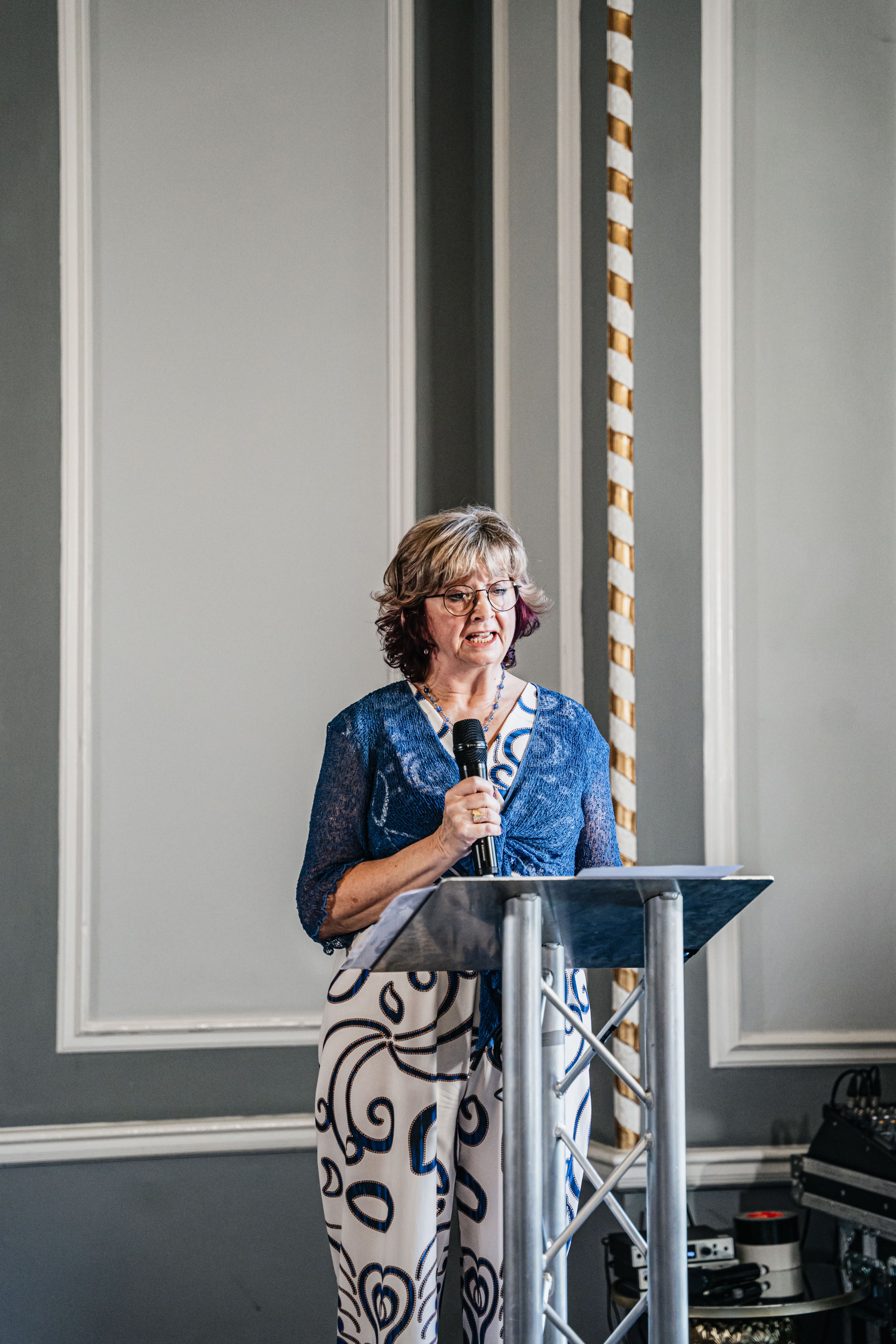
To Tom, ladies and gentlemen, esteemed ex-colleagues and honoured guests,
Today we gather to celebrate the achievements of many wonderful people from our profession, in particular our new president, Tom, and I am delighted to have been asked to deliver this address in his honour.
I have decided to reflect on the profound impact of kindness in our lives and in our profession. Indeed, I believe, it is kindness and compassion that underpinned my connection with Tom and which brings us together again today.
The Dalai Lama said: "Be kind whenever possible. It is always possible."
Now that I am no longer shackled by the rituals of academia I don't intend to provide a date or reference source, and neither can I swear that this is an accurate quote, a paraphrase or if the Dalai Lama even actually said this - but I found it on the internet so it must be true.
Kindness in care
Nevertheless, this simple yet powerful maxim underscores the essence of what it means to be truly human.
Kindness is not just an act; it is a state of being that ripples through our lives, touching hearts and changing futures. It is a force that binds us together, creating a fabric of support and empathy, especially in our field where human connection, both physical and emotional, is paramount.
In the realm of healthcare, kindness is indispensable. As radiographers we are entrusted with the well-being of others and patients rely on us to provide the care and services they need. But this means our relationship with patients is asymmetrical. Our expert knowledge puts us in a position of power, which can be intoxicating.
However, whilst it is nice to be important, it's more important to be nice. Our words and actions can uplift or discourage, heal or harm. When we are kind to our patients, we provide more than just medical care; we offer hope and reassurance. Kindness can ease the fear of a diagnosis, soothe the anxiety of treatment, and foster a healing environment that technical competence and skills alone cannot achieve.
Supporting each other
Equally important is the kindness that radiographers show to each other. The clinical environment is demanding, with long hours, high stress, and emotional tolls that can lead to burnout. In such a setting, a culture of kindness and mutual support is crucial. When colleagues show compassion and understanding towards each other, it creates a workplace where everyone can thrive, feel valued, and perform at their best. A simple act of kindness — a listening ear, a word of encouragement, a helping hand — can make a world of difference.
The same principle applies in education, where the influence of kindness is equally profound. Lecturers and educators hold the power to shape minds and futures. When they approach their students with kindness rather than authority, they foster an environment of trust and motivation. Students feel seen, heard, and valued, which can inspire them to reach their full potential.
Today, in Tom, I am reminded of a story that exemplifies the transformative power of kindness in education. I don't think he will mind me saying, Tom faced significant challenges during his studies in radiography. He could be a bit of a lad! Poor attendance, late assignments - you know the kind of thing. At one stage his future on the course seemed uncertain. However, rather than harshness, Tom was shown kindness, support and encouragement. With this guidance, he persevered, completed his course, and embarked on a career characterised by the same kindness that had been shown to him.
I am delighted to see he has continued to embody the principles of compassion and empathy throughout his career, as clinical radiographer, SoR regional rep and clinical educator, no doubt touching the lives of countless patients, colleagues and students in the process. Today, we celebrate Tom as he is inaugurated as president of our esteemed organisation. What a journey!
Our president
I have no doubt that in your presidential year, Tom, you will draw on your warm and kindly nature in all that you do. Your success is a beacon, reminding us all of what can be achieved when we nurture each other with care and understanding.
Tom's story is not just an individual success; it is a call to action for all of us. It asks us to reflect on the legacy we are creating through our actions.
Therefore I make a plea to you all. Commit to fostering a culture of kindness in all aspects of your lives. Recognise the power you hold to make a difference through simple acts of compassion. Whether you are treating a patient, supporting a colleague, or guiding a student, do so with kindness at the forefront of your minds. By doing so, you not only enrich the lives of those around you but also pave the way for a more compassionate and connected world.
Thank you and may kindness continue to guide us in all our endeavours.
Best wishes Tom, you’ll shine in your new role
Dr Leslie Robinson
Gallery
Image credit: Eva Slusarek




